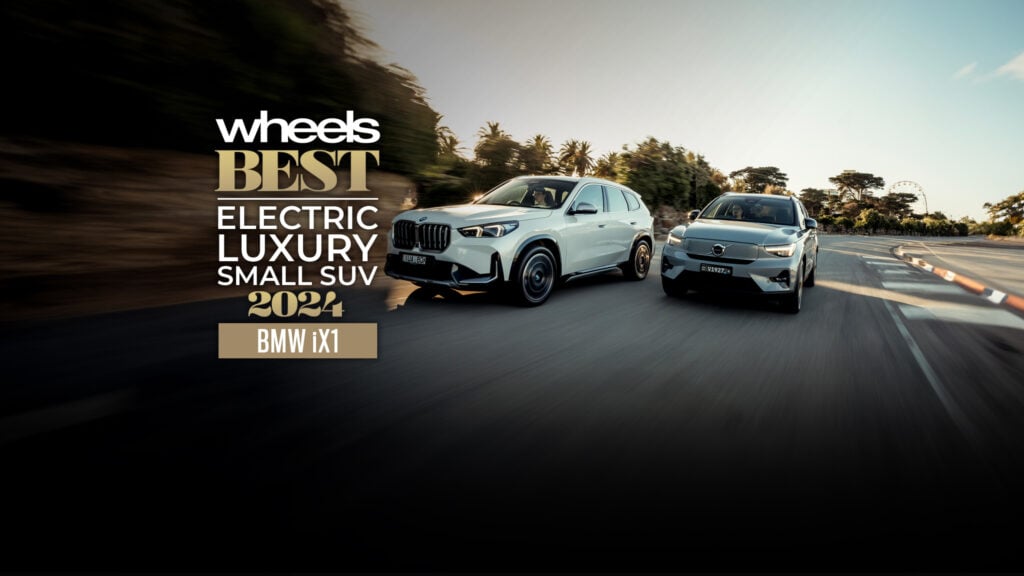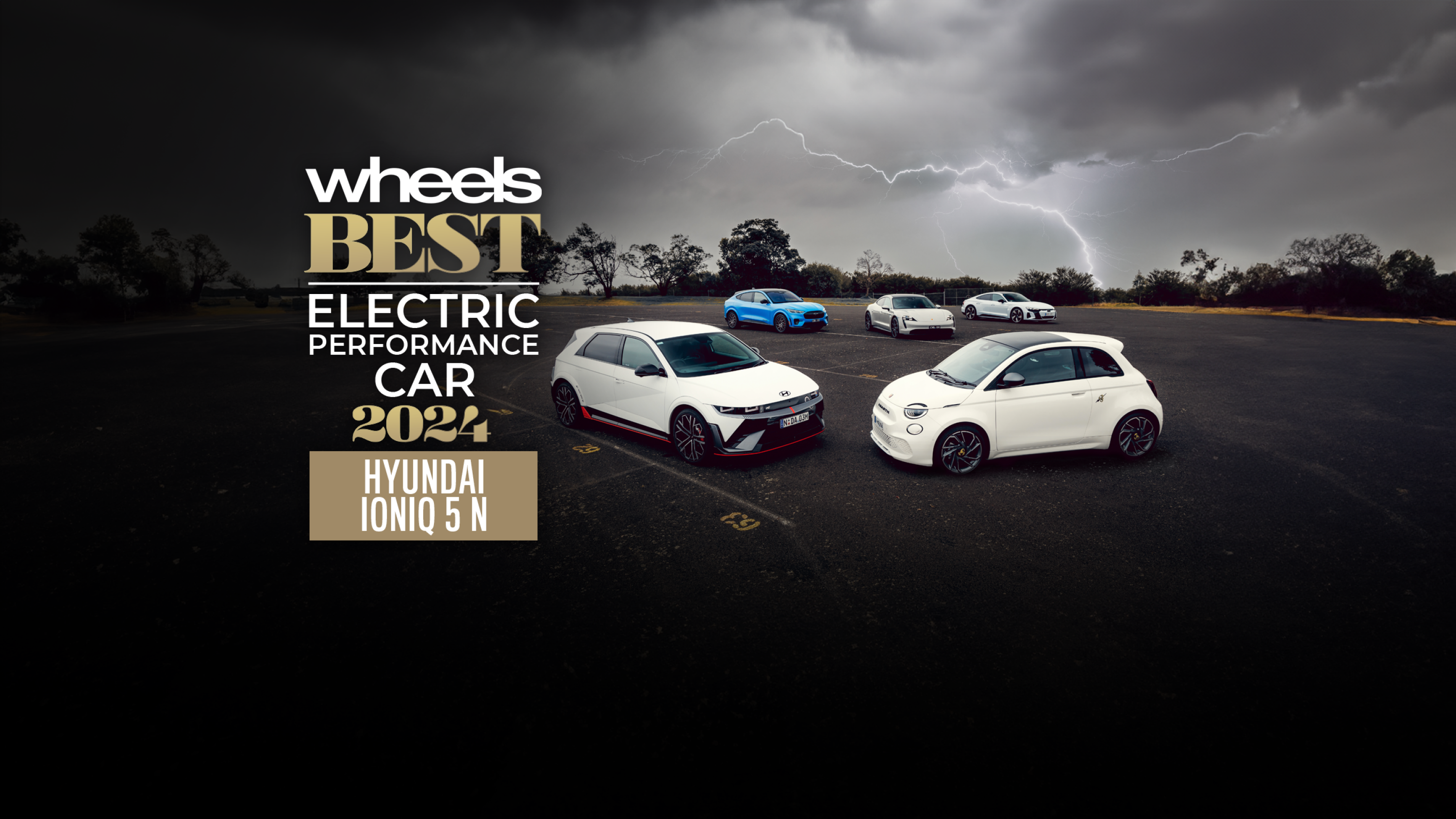
Cautiously optimistic. That’s how I’d describe the mood among the Wheels road testing team as we arrive at our meeting spot on the outskirts of Moe in southern Victoria.
It’s drizzling and three of the four charging stations we need to use before we can hit the track are broken, yet there’s a fizz of excitement rippling through the team. A group of electric cars pitched at keen drivers? It feels like we’ve been waiting years for this.
Inevitably, each car cops an appraising eye as it rolls into the carpark. The Porsche gets some knowing nods, the Audi turns heads like a Milanese catwalk model and if we could have squeezed the cheeks on the impossibly cute Abarth 500e, we would have.
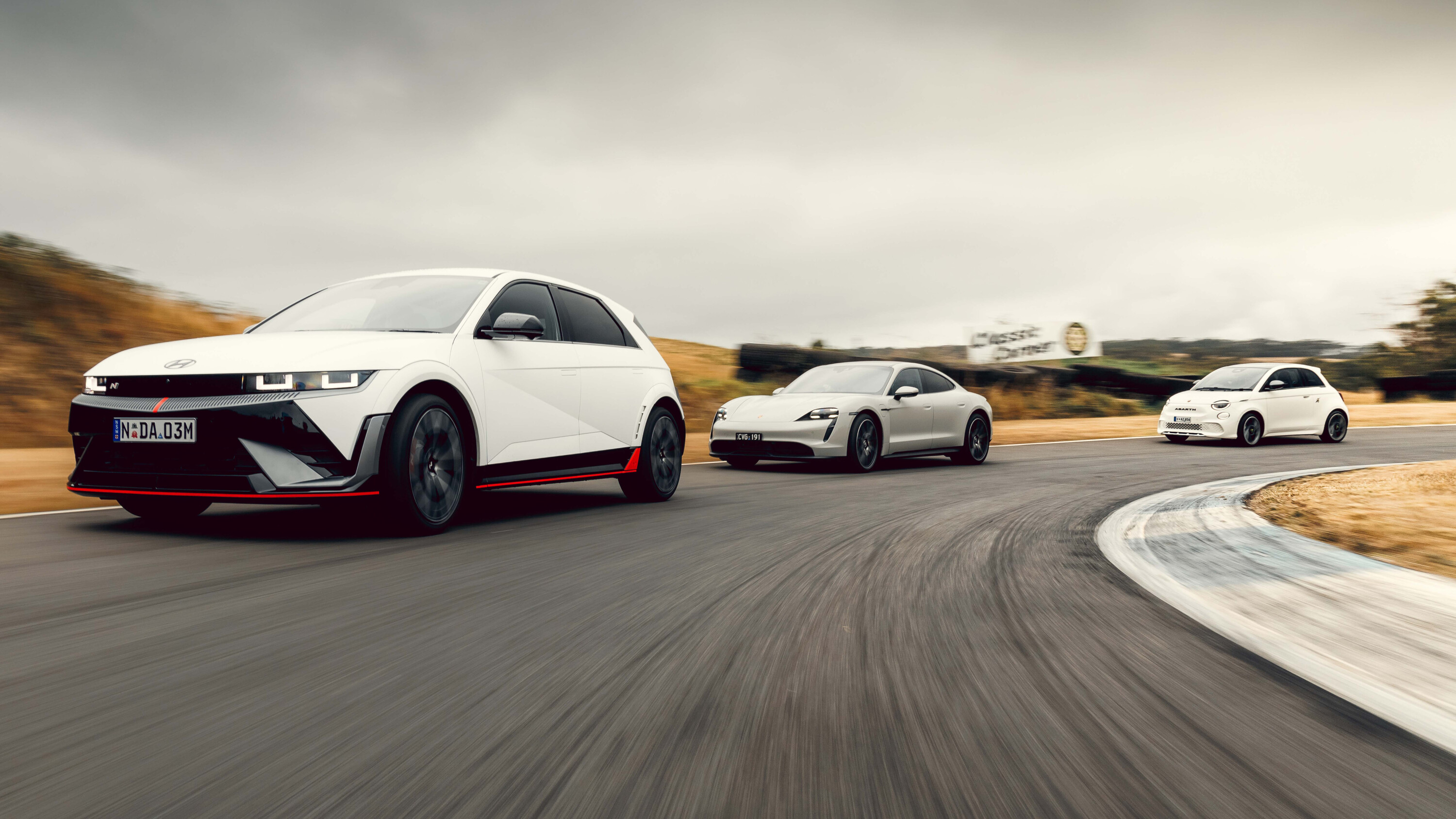
The Mustang Mach E gets a more reserved reception — can this really be a Mustang!? — but it’s the Hyundai Ioniq 5 N that keeps drawing our eye. It’s easy to see why.
No other car is so hyped nor, it has to be said, quite so intriguing. Where the others are proven contenders capable of brutish acceleration and grippy dynamics, the Hyundai promises to deliver the one thing EVs have so far been short on: soul.
And that’s the crux of it, isn’t it? If you’re someone who loves driving, and I’m guessing you are, then chances are your verdict is still out on electric cars. Speed is one thing but engagement and driver involvement are other metrics entirely, which is why you won’t find a Tesla Model 3 Performance in this group.

Today is about exploring cars with genuinely driver appeal, and while the Model 3 and Model Y are undoubtedly fast and powerful, they aren’t pitched as driver’s cars.
It’s the same reason we aren’t testing the Ioniq 5’s Korean cousin, the Kia EV6 GT.
So why have we chosen a base Porsche Taycan and not one of the more powerful and focused versions higher up the model range? Partly that’s because we already have the flagship Audi RS e-tron GT, which shares its underpinnings and key hardware with the Taycan Turbo, but also because we’ve long suspected that the cheapest Taycan might actually be the pick of the lot.

At $175,100 the base Taycan also provides an interesting counterpoint to the $111,000 Ioniq 5 N.
Can the less expensive and more powerful Hyundai really topple a performance car created by the masters of driver-focused dynamics? Hyundai beats Porsche. Now that’s a headline.
The real question we’re seeking to answer, however, is whether the growing wave of electric cars holds genuine interest for driving enthusiasts.
To do that, we’ve commandeered the tight and technical Haunted Hills high climb circuit and also devised a short but gruelling road loop. A 300km round trip transit leg out of Melbourne and a full day of circuit driving should also prove an interesting test of Victoria’s recharging infrastructure and the feasibility of using a performance EV for a weekend punt. Game on.
Alex Inwood
JUMP AHEAD

5️⃣ Ford Mustang Mach-E
When Holden made the decision to extend the Commodore nameplate to a Vauxhall, there was a tangible sense of uncertainty in the air.
Few beyond the confines of the head office were entirely convinced that a nameplate could seamlessly transition to a member of a different automotive lineage. In the same way, I’ve noticed that the Mustang Mach-E has gradually begun to shed its association with the “Mustang“, with many now simply referring to it as the Mach-E.
The logic from the decision makers does make some sense; that the Mustang Mach-E acts as an electric rendition of a muscle car.
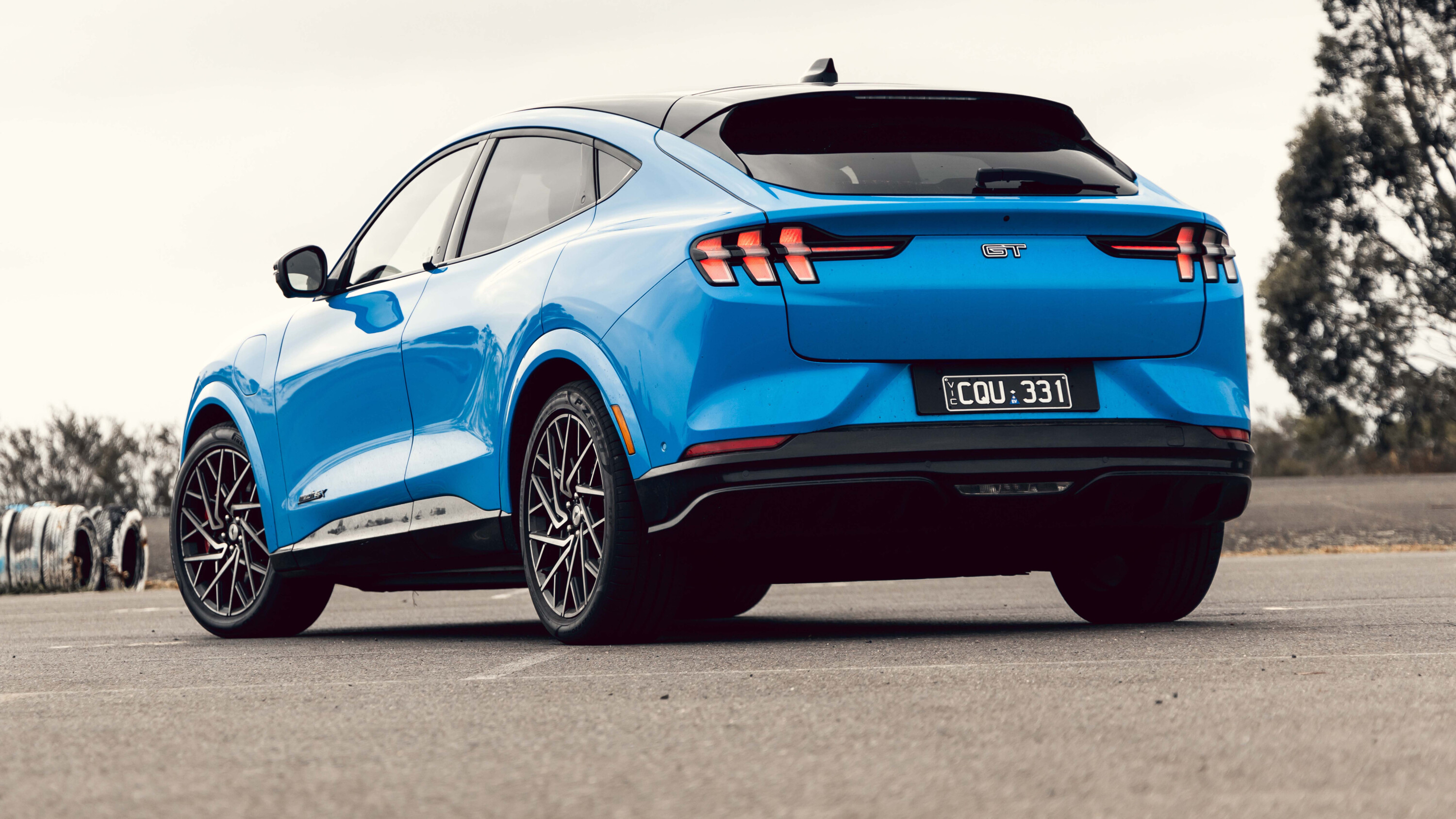
And with a performance focus and a claimed 3.7 second 0-100km/h time, this flagship Mach-E GT was an easy contender to add to our performance EV test.
Externally, you’re greeted with a sleek, streamlined body. In the eye-catching Grabber Blue metallic paint we had, it flaunts a striking design that could potentially win over many Mustang enthusiasts, provided they set aside their biases.
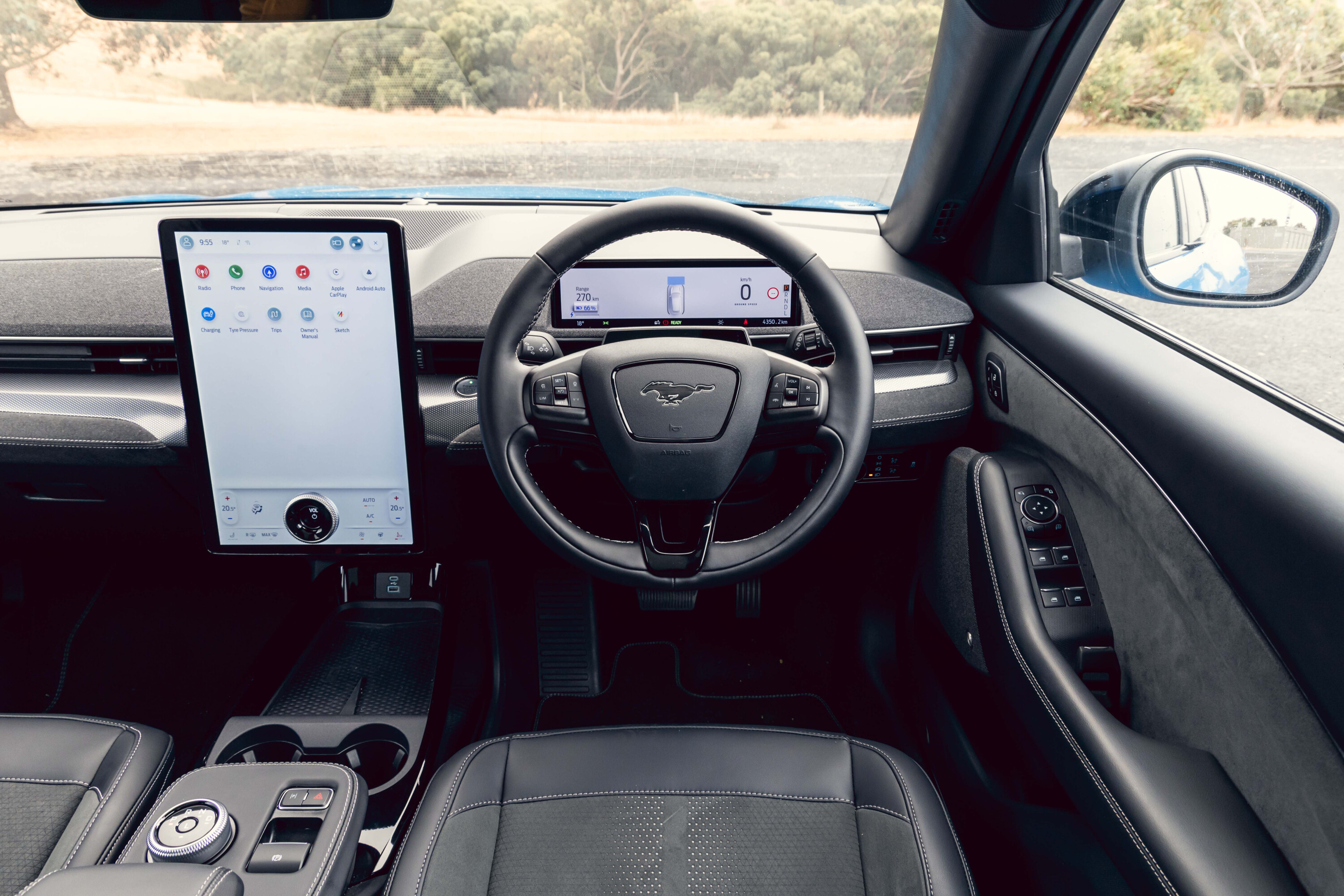
Inside, there’s much to appreciate with an impressive list of technology.
A massive 15.5-inch portrait-style touchscreen commands the cabin, complemented by a smaller full-digital display behind the steering wheel. Paired with wireless Apple CarPlay and a banging 10-speaker Bang & Olufsen sound system, it feels like you’ve stepped into an aisle at JB Hi-Fi. Additionally, the button door openings and keypad entry are cool novelties.
Unfortunately, when compared back-to-back with other vehicles, the Mach-E stood out as the weaker vehicle. The transition from regenerative to disc braking was abrupt, something none of us could adapt to neither on track or on road.

The suspension was also much harder than expected for a car equipped with adaptive dampers. Compared to the IONIQ 5, it’s a night-and-day difference in terms of what you’d expect from the feature.
On the track, body control was only so-so and in all settings the car itself feels big and heavy – its actually larger than a Toyota RAV4. That does mean you’re treated to a good amount of space inside, however.
In the realm of sport ESC, you have the opportunity to leverage rear bias and utilise body roll to your advantage. However, once you begin to push beyond those limits, challenges arise.
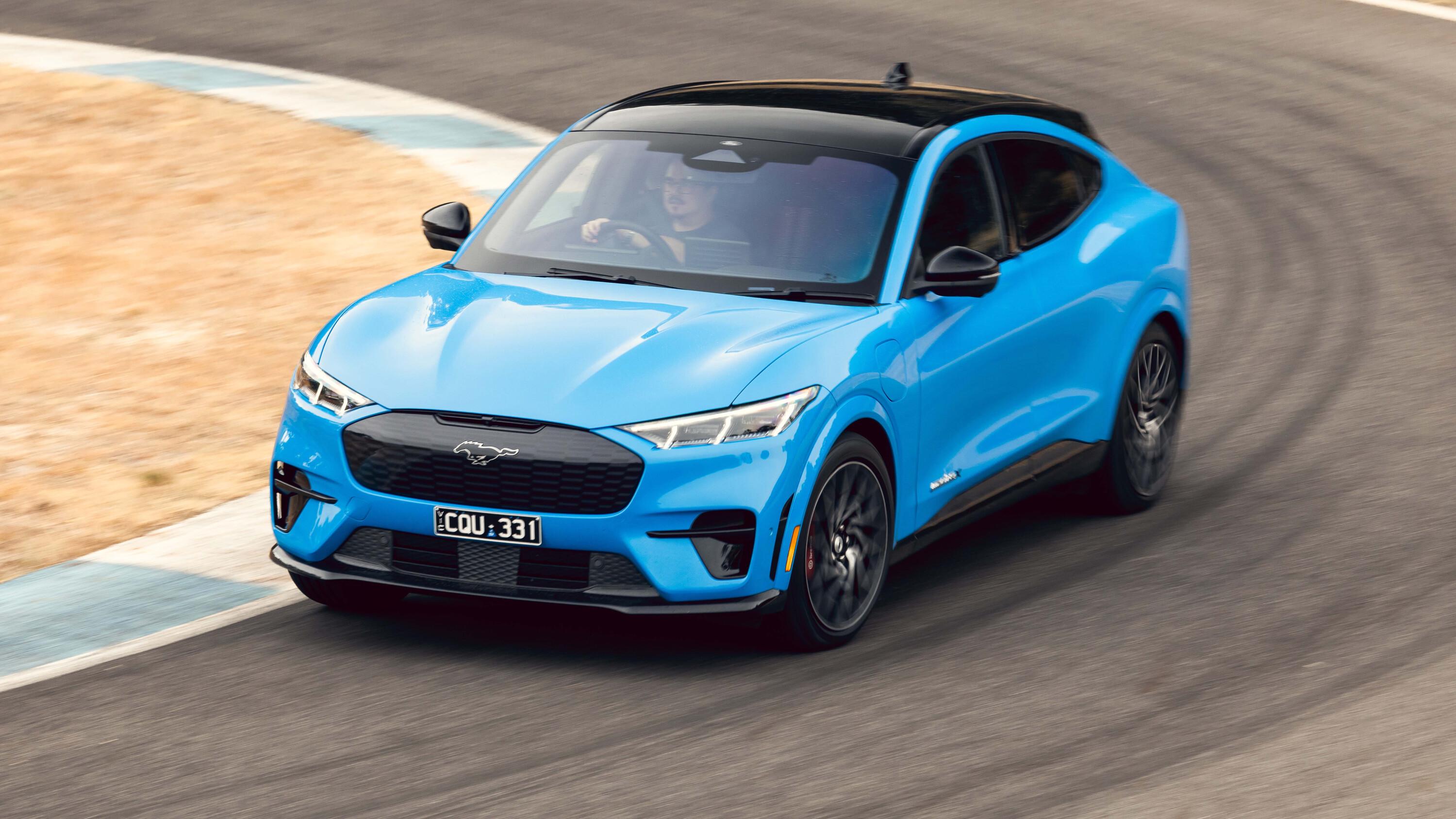
Turning off all electronic aids doesn’t unleash a playful, oversteering balance; instead, it exacerbates understeer.
That isn’t to say the Mach E isn’t without merit. It’s a teched-up car, with a decent amount of range that could easily get you through the week and enough straight-line performance to silence most skeptics. But in the case of today’s test, this Mach-E was out of its depth.
At $104,990 before on-road costs it was quickly outclassed by the Ioniq 5 N which set the benchmark for us quite quickly on the day.
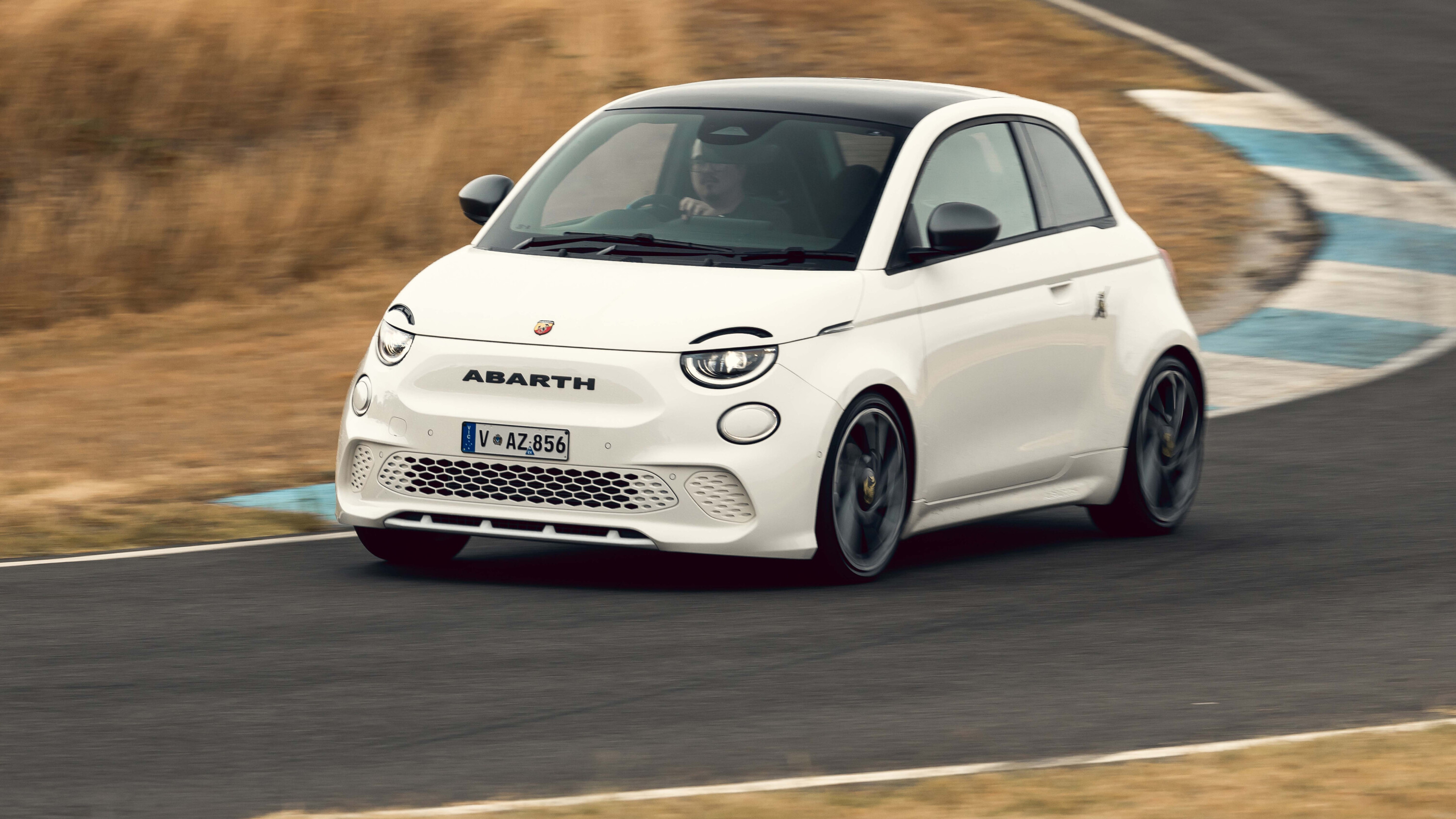
4️⃣ Abarth 500e
Loud and proud but under-endowed
I’ve driven 102km along the freeway from work and I’ve consumed over 50 percent of the Abarth’s battery. That right there will tell you why people who love driving won’t buy this car. Because the Abarth’s tiny 37.3kWh useable battery won’t let you do a great deal of it.
I get it. There’s a place for small cars with small batteries and that place is in the city. There you can quite happily zip about in what will likely be a second or third car, not particularly worried that this
Turismo trim level costs a smidge under sixty grand nor that the 18-inch wheels rob around 11km of range over the 17-inch items our Euro cousins get.
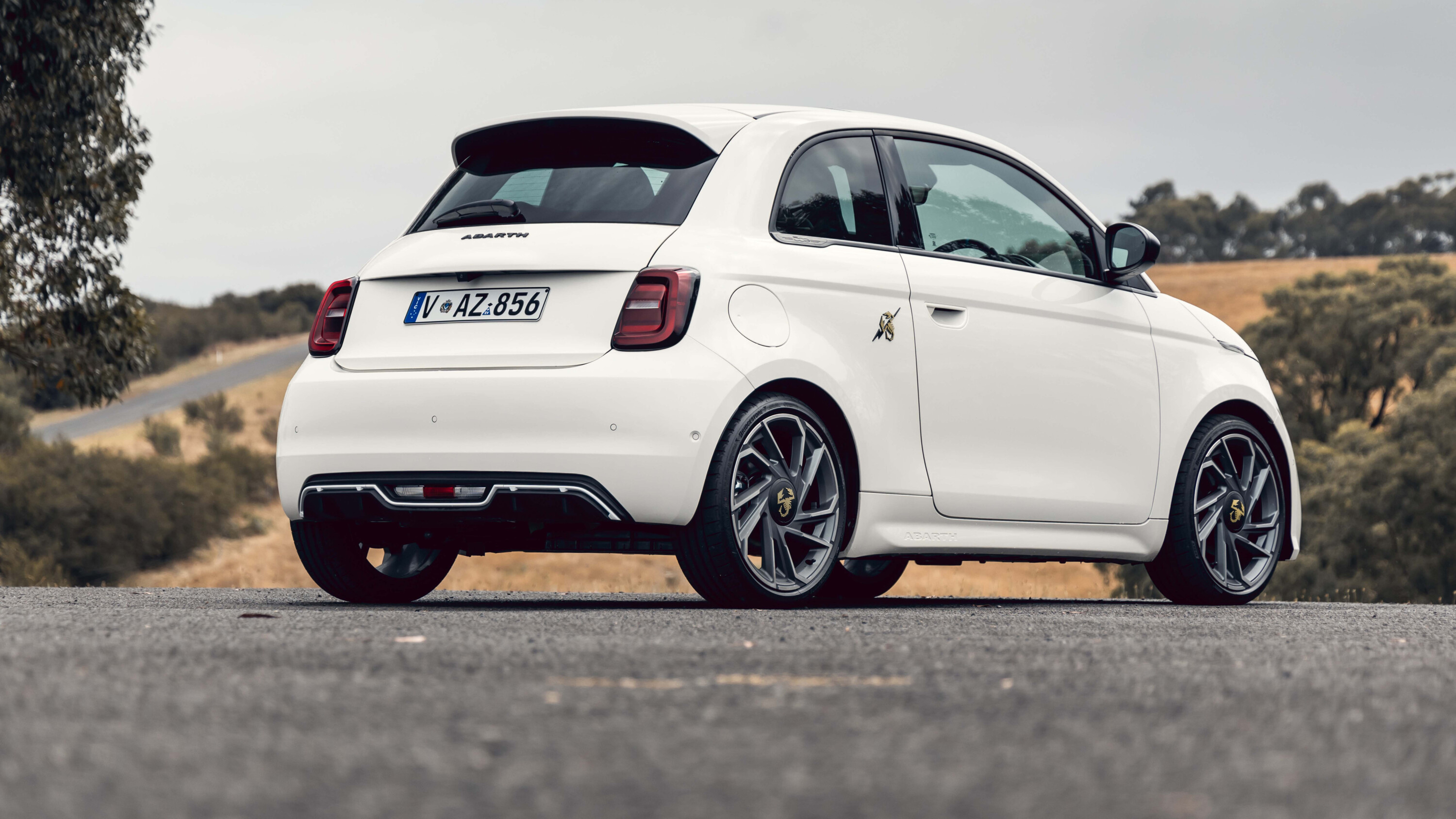
It’s hard to be sour about for long, though. I even love the Abarth Sound Generator, effectively a huge cake-tin of a speaker mounted to the underside that emits a fake engine sound.
It’s obnoxiously loud when engaged and sounds reasonably good when pitching up and down the rev range. It’s not so enjoyable at steady revs on a highway and you can only switch it off by bringing the car to a halt and engaging the handbrake which, if you’ve neglected to do so before you drive down the on-ramp, will have you hating life within about twelve seconds.
Otherwise the ergonomics are much improved. The seating position is rather high, which will affect taller drivers and the car’s target market hardly at all.
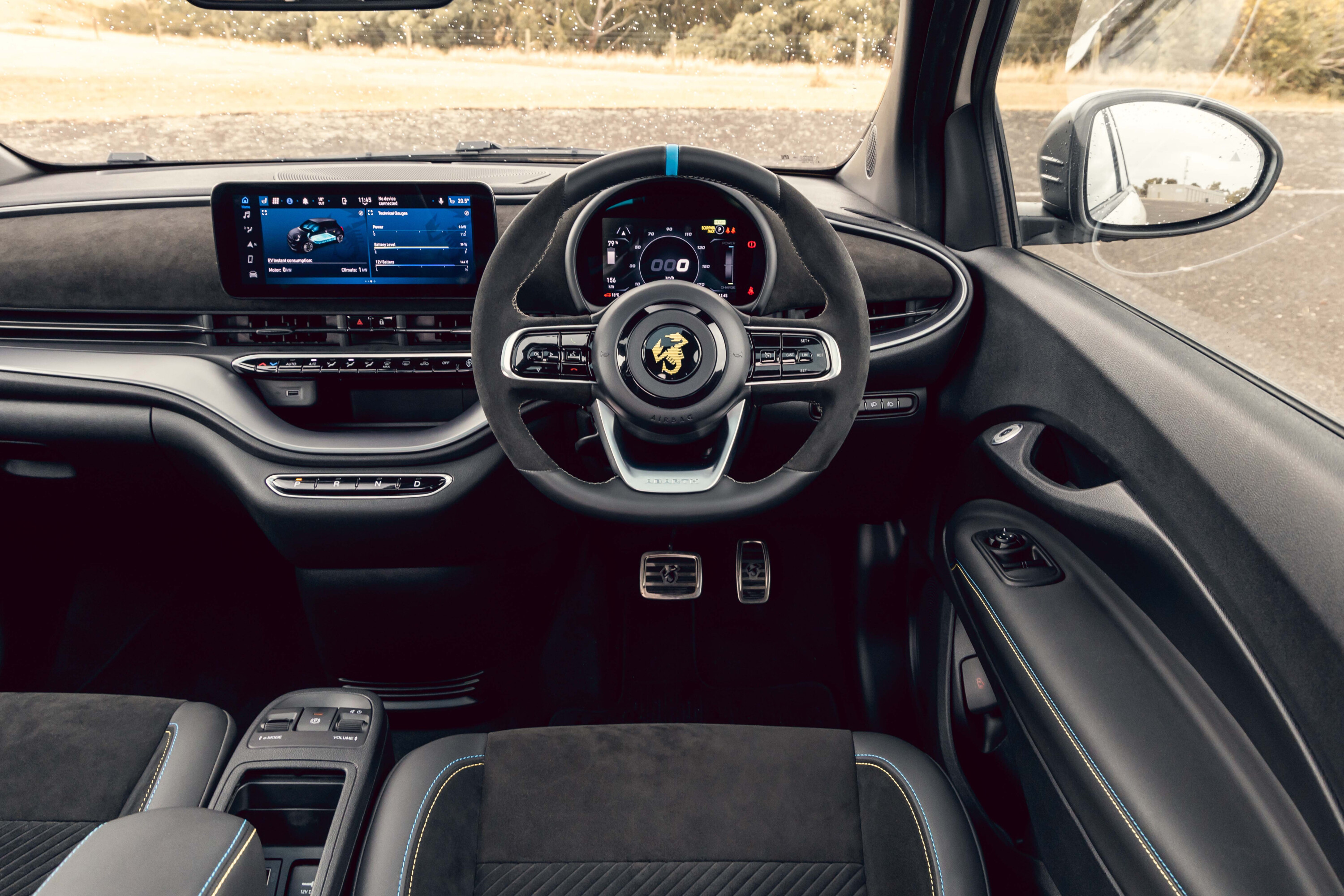
The body control, grippy Alcantara-trimmed sports seats and beautifully-weighted steering are excellent
You get wireless Android and Apple, a reasonable stereo and some cutesy Easter eggs dotted about the cabin, such as the outline of the Turin skyline on the wireless charging pad and the original Cinquecento etched into the interior door pulls. It’s almost pathologically endearing.
It’s a hoot to power down out of corners, but even with a relatively modest 114kW/235Nm at its disposal, it can occasionally spin up a front inside wheel if you’re particularly unsubtle with the throttle.
The body control, grippy Alcantara-trimmed sports seats and beautifully-weighted steering are excellent; the cramped footwell with nowhere for your left foot to go significantly less so.
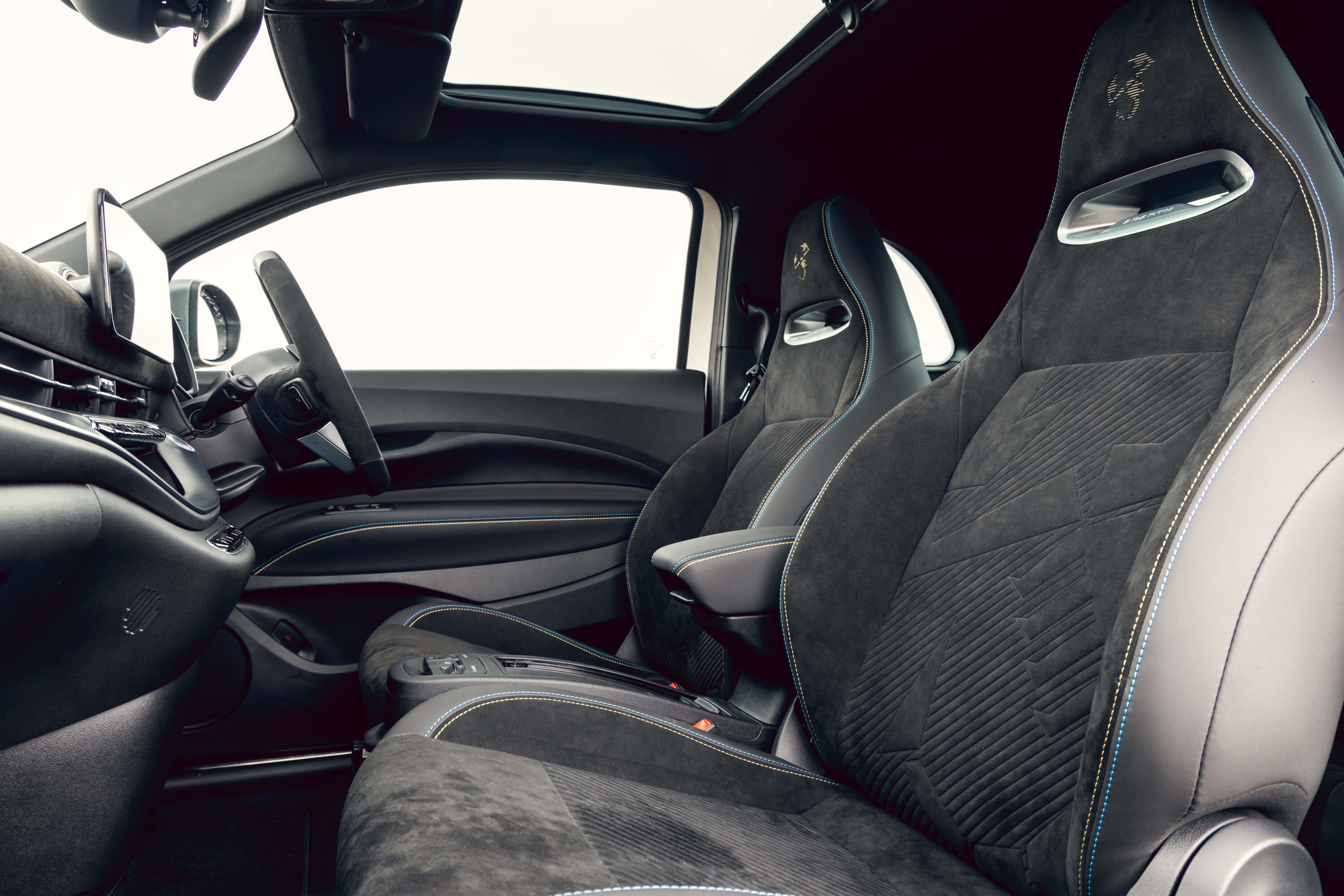
The handling is safe, decently tactile but largely prescriptive. At 1410kg, it’s not hugely hefty but it isn’t presented as an enthusiast’s car.
‘Scorpion Track’ mode is the only one that disables one-pedal driving and the stability control never switches fully off. Again, while stringback glove types like us may bemoan that choice, it’s probably right for the typical buyer.
Ride quality is firmish and outright grip from the Bridgestone Potenza Sport tyres is impressive. While it feels outgunned in this company, everybody emerged from the Abarth with a grin on their faces. Yes, it’s a lot of money for what you get, which in the context of what else is out there for that price is eye-widening.
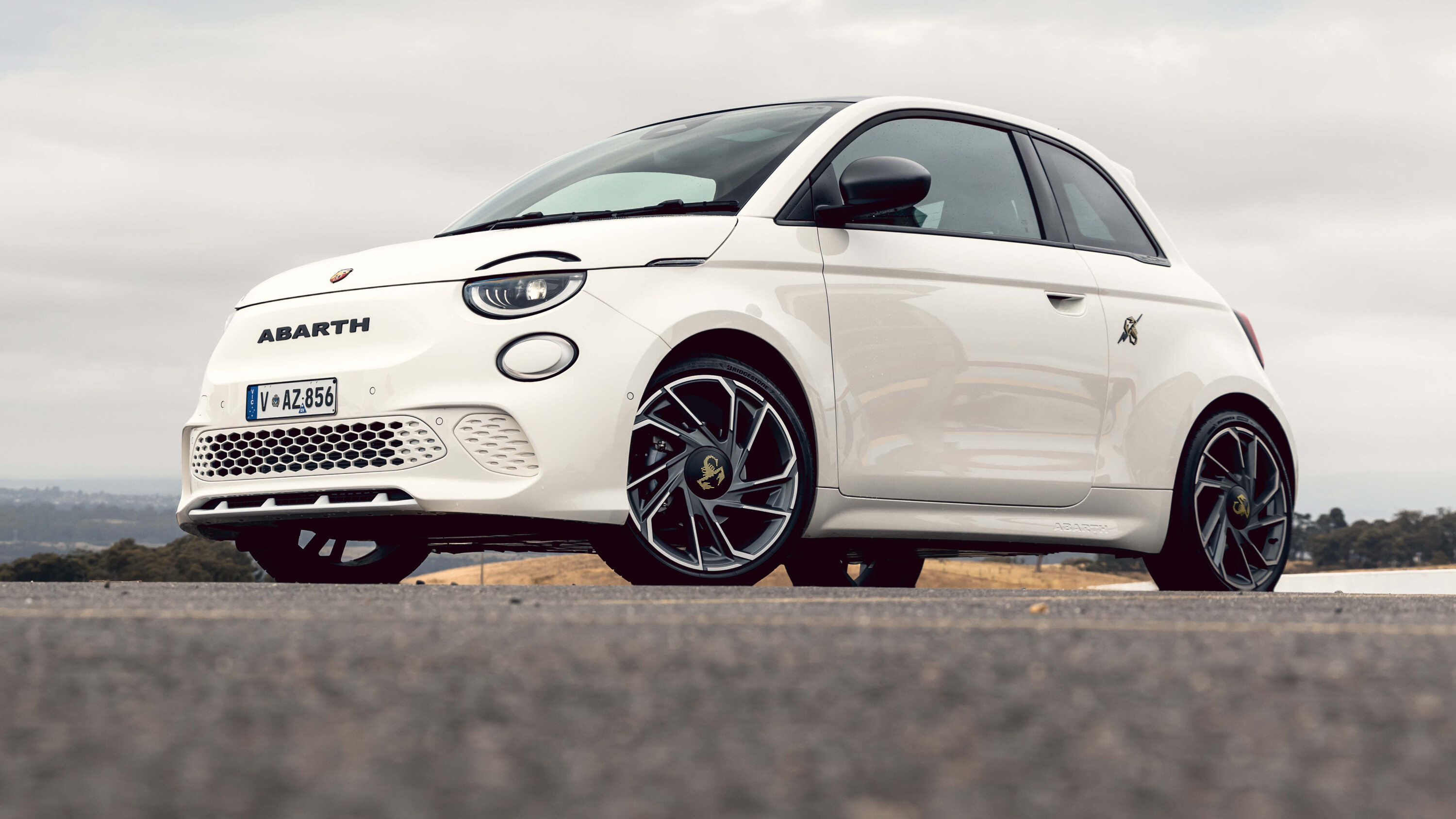
Abarth must feel, or indeed hope, it’s playing to a demographic that is implacably price insensitive.
Its peak charging speed of 85kW means a zero to 80 percent charge will detain you for 35 minutes, in which time you’ll have added around 160km of real world range. By contrast, the Hyundai Ioniq 5 N would have reached 80% in a tick over 20 minutes and shovelled in double the kilometres, so with the 500e know that you’re not buying the most advanced EV architecture.
But then there’s a long list of things that nearly $60K isn’t buying you with the Abarth 500e. We took it a long way offhome turf for this test and that also needs to be taken into account. It still charmed everyone. What price do you put on that?
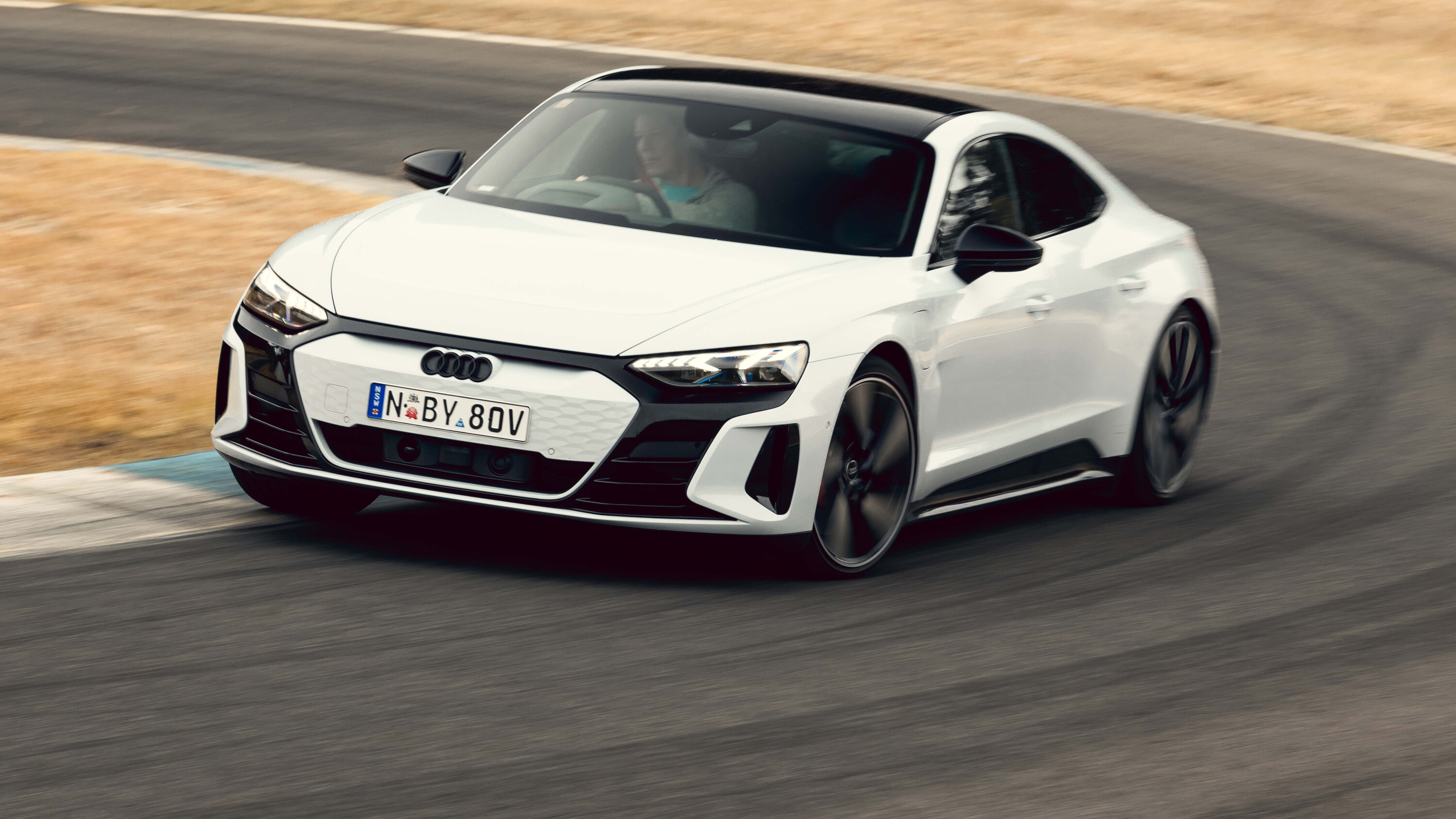
? Audi e-tron GT
Audi’s low-flying spaceship defies physics… but that’s the problem.
If this was a beauty contest, the RS e-tron GT would have won the instant it rolled through the gate. Long, low and wide, with coke-bottle hips and a bonnet the size of a tennis court, Audi’s top-tier electron-burner is a flagship that looks like a spaceship, and one that compelled all who gazed at it to profess their love for it, unprompted.
But aesthetic appeal doesn’t mean athletic appeal, and the Audi has some factors working against it. For one, its size. It measures a smidge under five metres long and is three centimetres wider than a 300 Series Landcruiser, and that can make for some nervousness when threading through traffic or trying to squeeze into a tight charging station. It’s a dense thing too, with its 2422kg kerb weight making it heavier than a Prado.
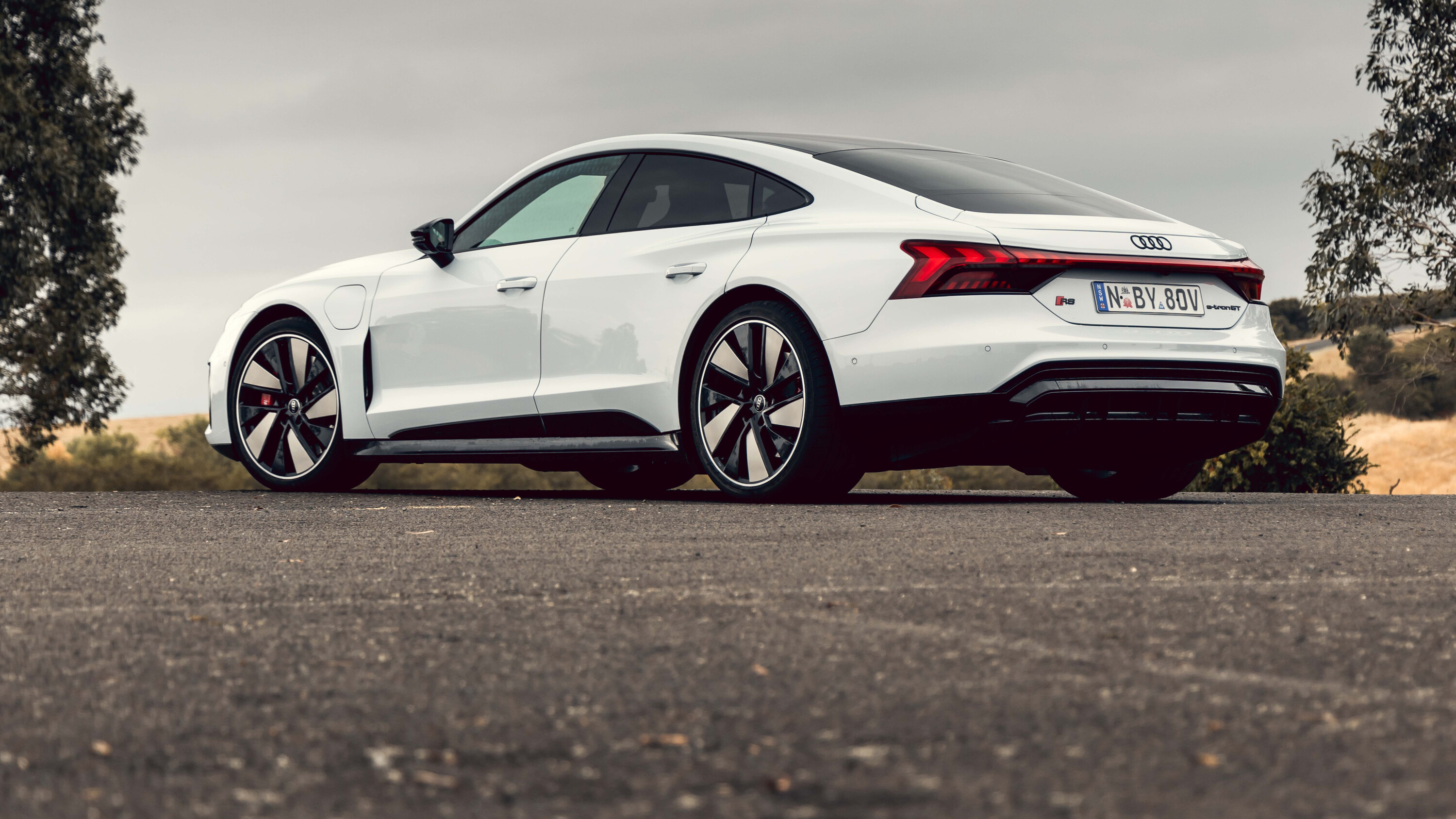
Accordingly, as it slinks out of the pre-grid onto the confined Haunted Hills circuit, I feel like a mariner easing a superfreighter through the Suez. I decide I’m going to take the first few laps easy.
If I jam this thing sideways into the dirt it’s going to be a catastrophe on a scale greater than the Ever Given, because the only thing more colossal than the RS e-tron GT’s footprint is its price – $260,525, as you see it before you, or $246,875 if you forgo the black badging, red contrast stitching on the interior, microsuede headliner, heated rear seats and massaging front seats. Better be careful.
But it doesn’t take long to realise the Audi has so much grip that its fearsome speed and supercar-slaying 3.3-second 0-100km/h performance are easy to contain. After a few more laps I start to wonder… is there maybe too much traction?
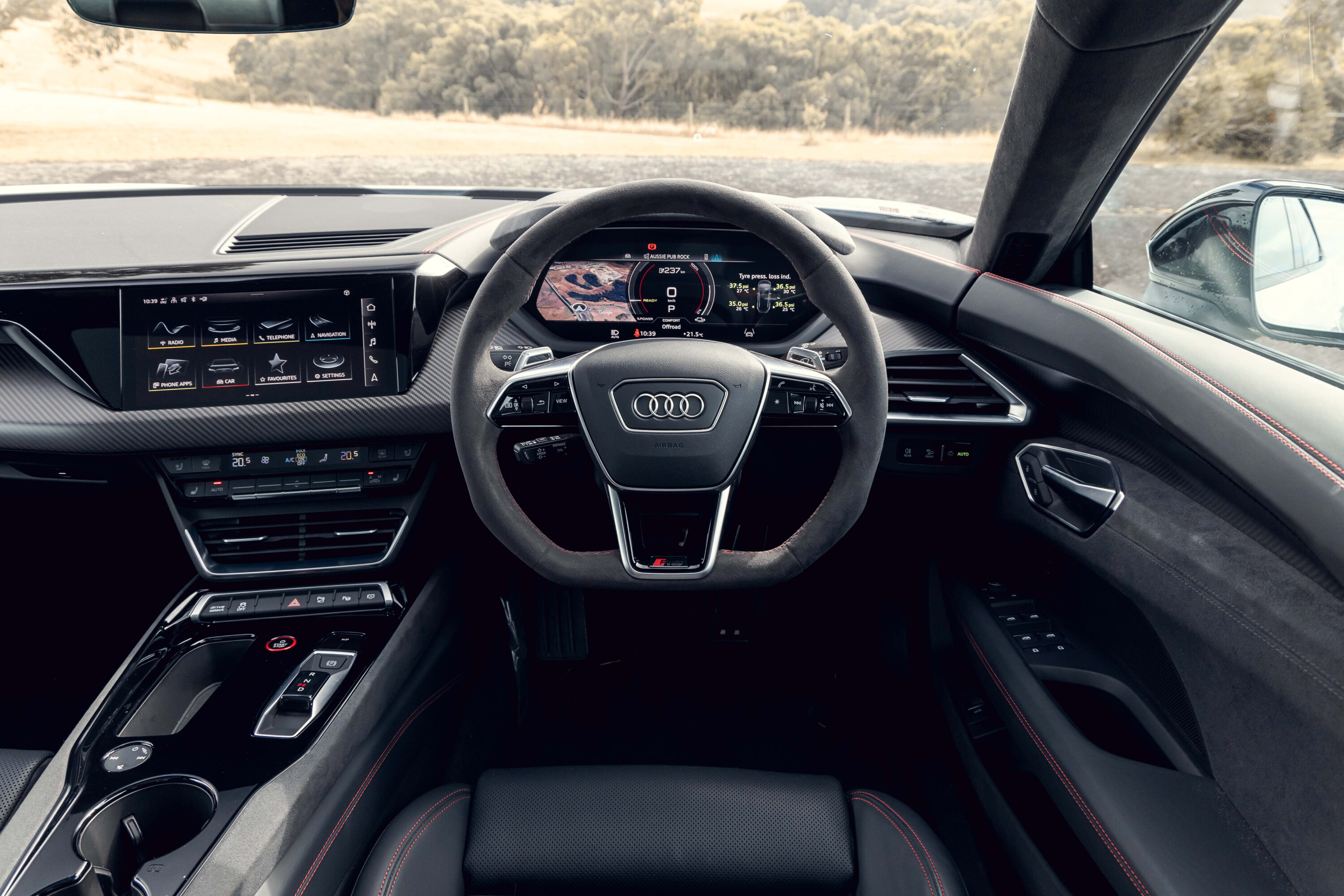
Just keep turning the wheel – there’s way more lateral stickiness than you’d expect
Its Goodyear Eagle F1s measure 265mm wide at the front and 305mm wide at the rear, and they, working in conjunction with the car’s active rear steering and torque-vectoring differential, make this land-yacht grip like a barnacle.
Just keep turning the wheel – there’s way more lateral stickiness than you’d expect, and the air suspension does a stupendous job of reining in body movement on this 2422kg monster. Pitch and roll? You barely feel either.
It can be convinced to slide, but only if you deactivate stability control all the way and transfer as much weight off the rear wheels before stabbing the throttle – and have the commitment to keep the hammer down as the big Audi rapidly gathers speed in a powerslide.
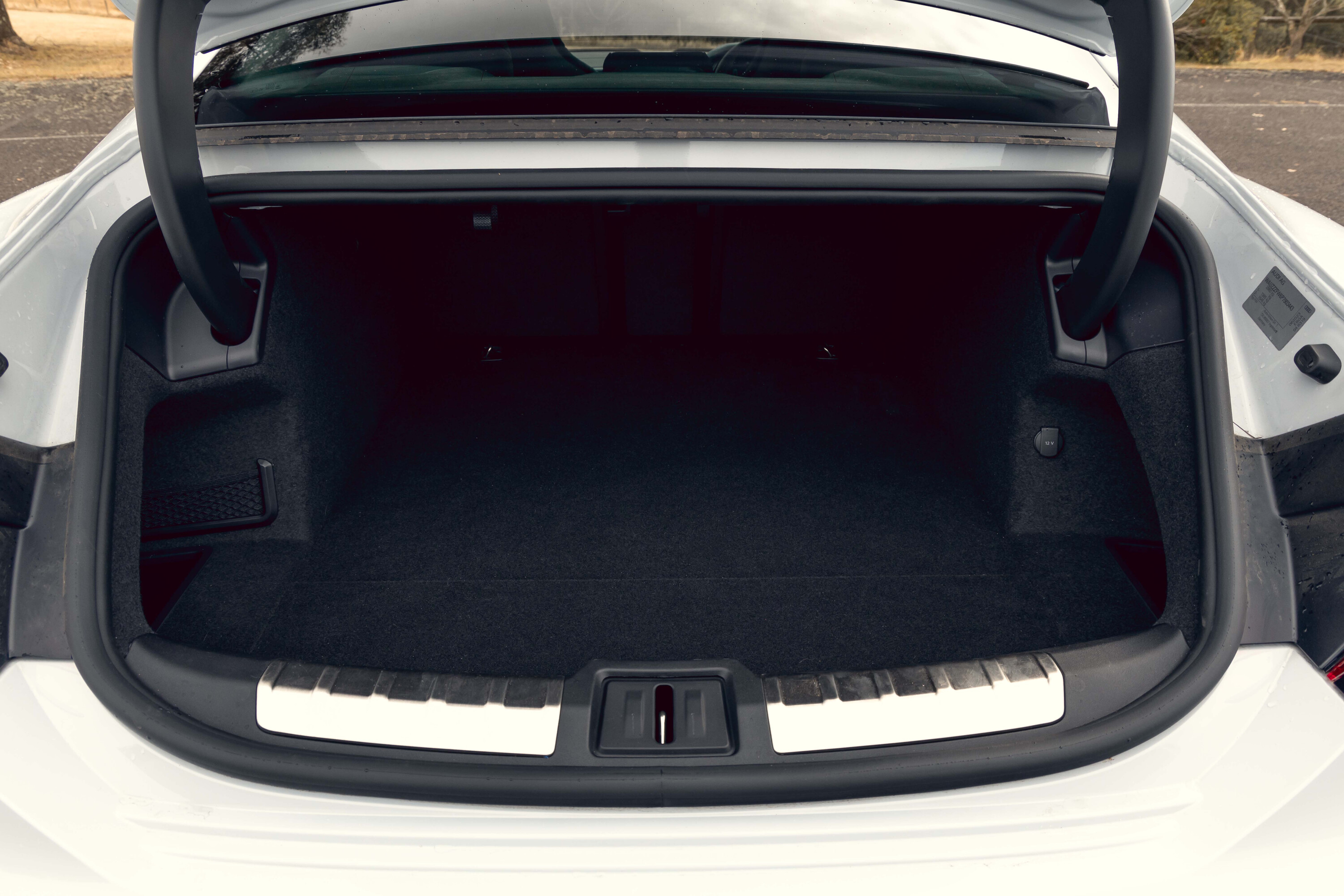
Speaking of, it accelerates like a boulder pushed out of a Zeppelin. Not just from a standing start, but from pretty much any speed.
Haunted Hills is a fairly confined track so it’s hard to really get above 130-ish km/h, which is where the e-tron GT’s two-speed transmission would start to shine, but the grunt that’s summoned up from a firm squeeze of the throttle pedal is magnificent, and it’d be a weapon at, say, Phillip Island.
On the other side of the dynamic equation, the e-tron GT’s brakes pull up strong, and there’s no real discernable handover between the regen and mechanical brakes either – the former of which can recoup up to 265kW of energy before calling on the beefy red-painted calipers to bite into the dinner-plate rotors.
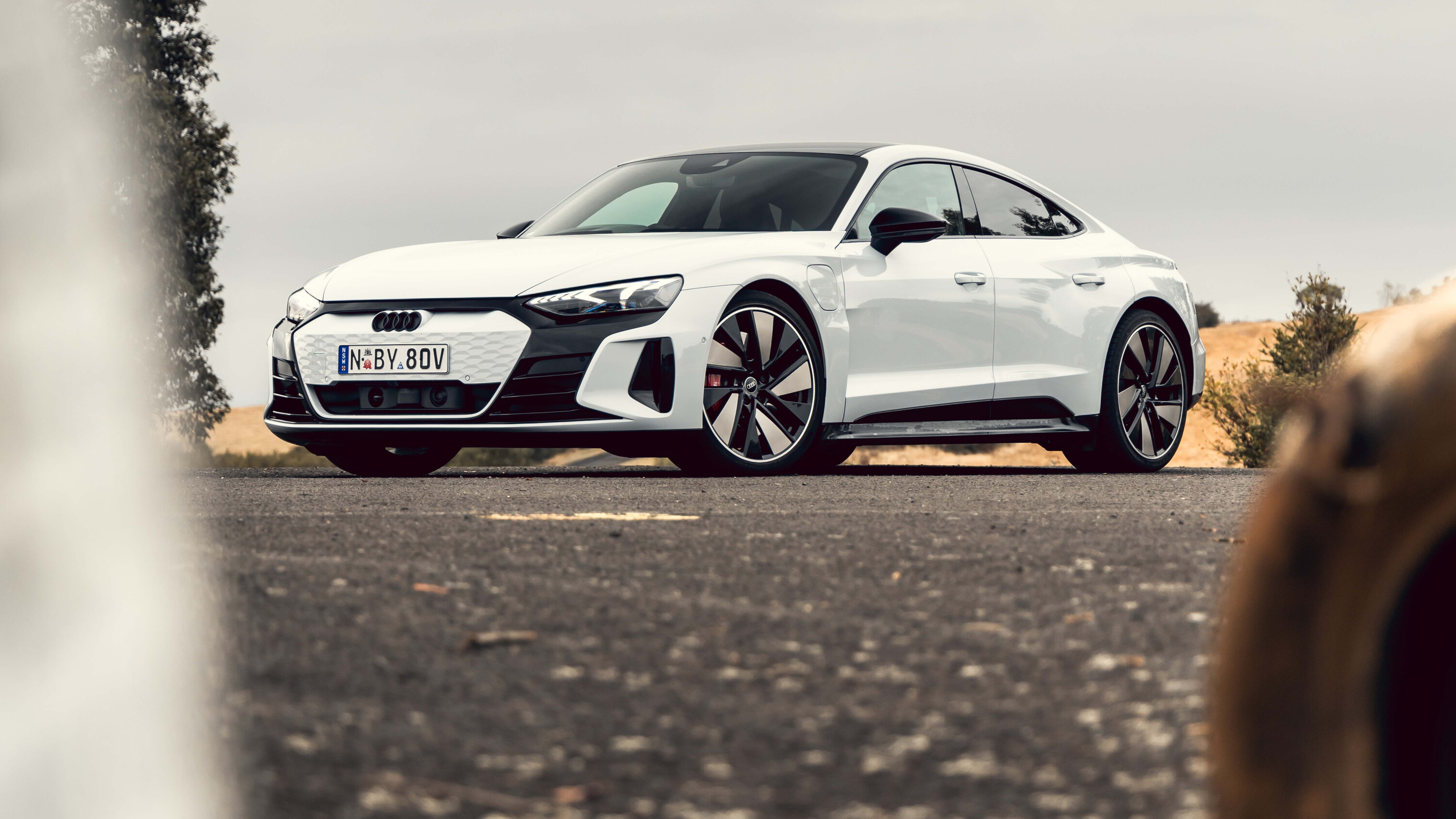
It is savagely fast and head-spinningly so, but it’s no challenge to tap into its performance: and that’s why it’s hard to truly love it as a driving enthusiast.
It’s short on drama, and as a product of the Audi Sport division that wears the vaunted ‘RS’ badge on its bootlid, the hotted-up e-tron GT doesn’t seem to have the same sporting sparkle as other members of the RS family.
No lairy drift mode, no flashy vehicle telemetry displays on the infotainment or HUD, no way to easily key into what this chassis can do. That’s really the main reason why this high-tech luxurious spaceship sits in position three, because when it comes to driver engagement, the next two cars do it a whole lot better.
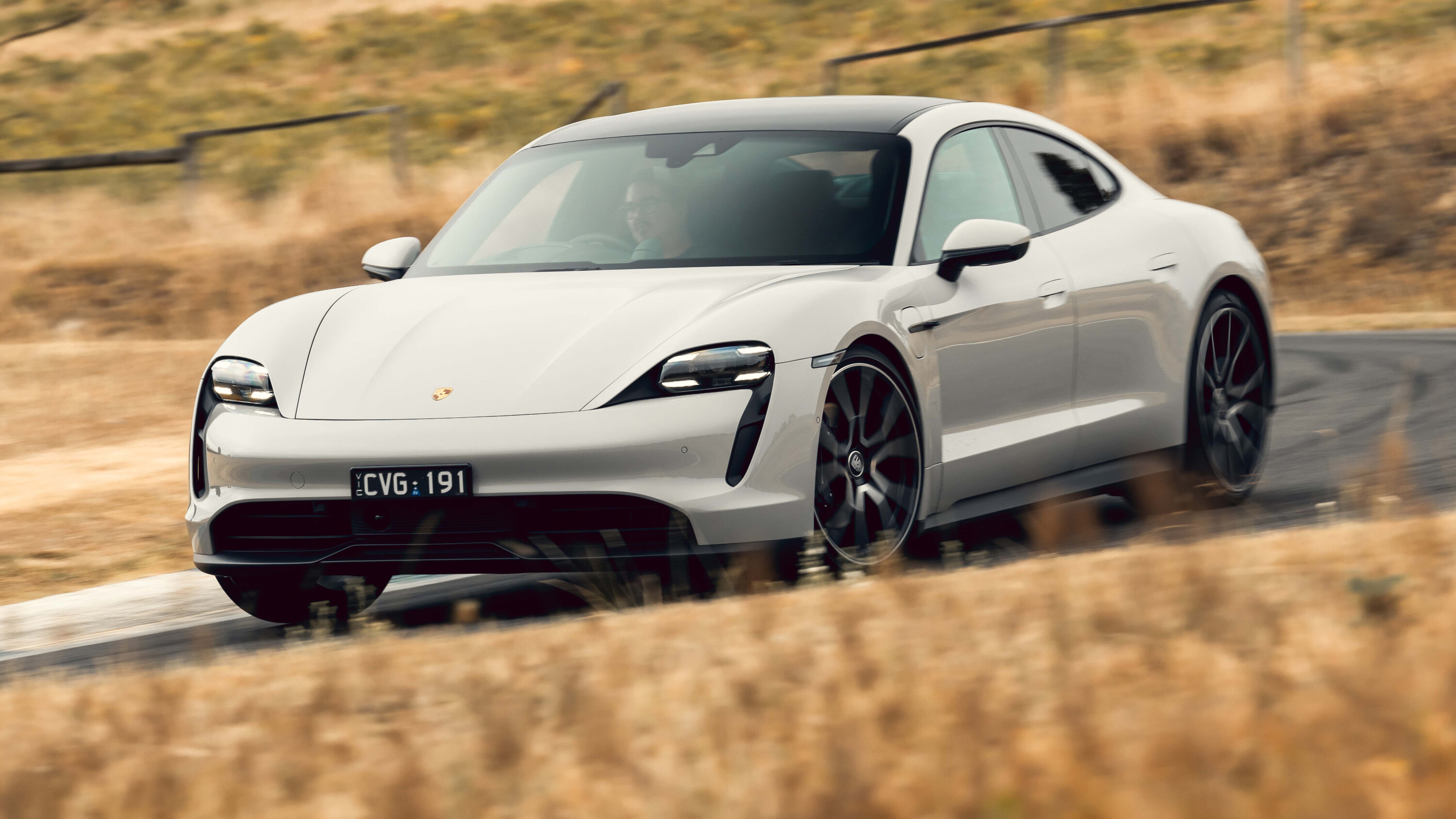
? Porsche Taycan
As pistons and spark plugs make way for synchronous electric motors and lithium-ion batteries, at least one constant could survive far into the electric performance car age: rear-wheel-drive.
If it wasn’t for rear-wheel-drive, we mightn’t pay much attention to the still relatively new, base model Porsche Taycan.
Outputs of 280kW and 357Nm from its lone electric motor look like that of a stick blender compared to pricier dual-motor models, yet the base could be the driver’s pick of the Taycan range in much the same way you might take a Toyota GR86 over a Volkswagen Golf R.
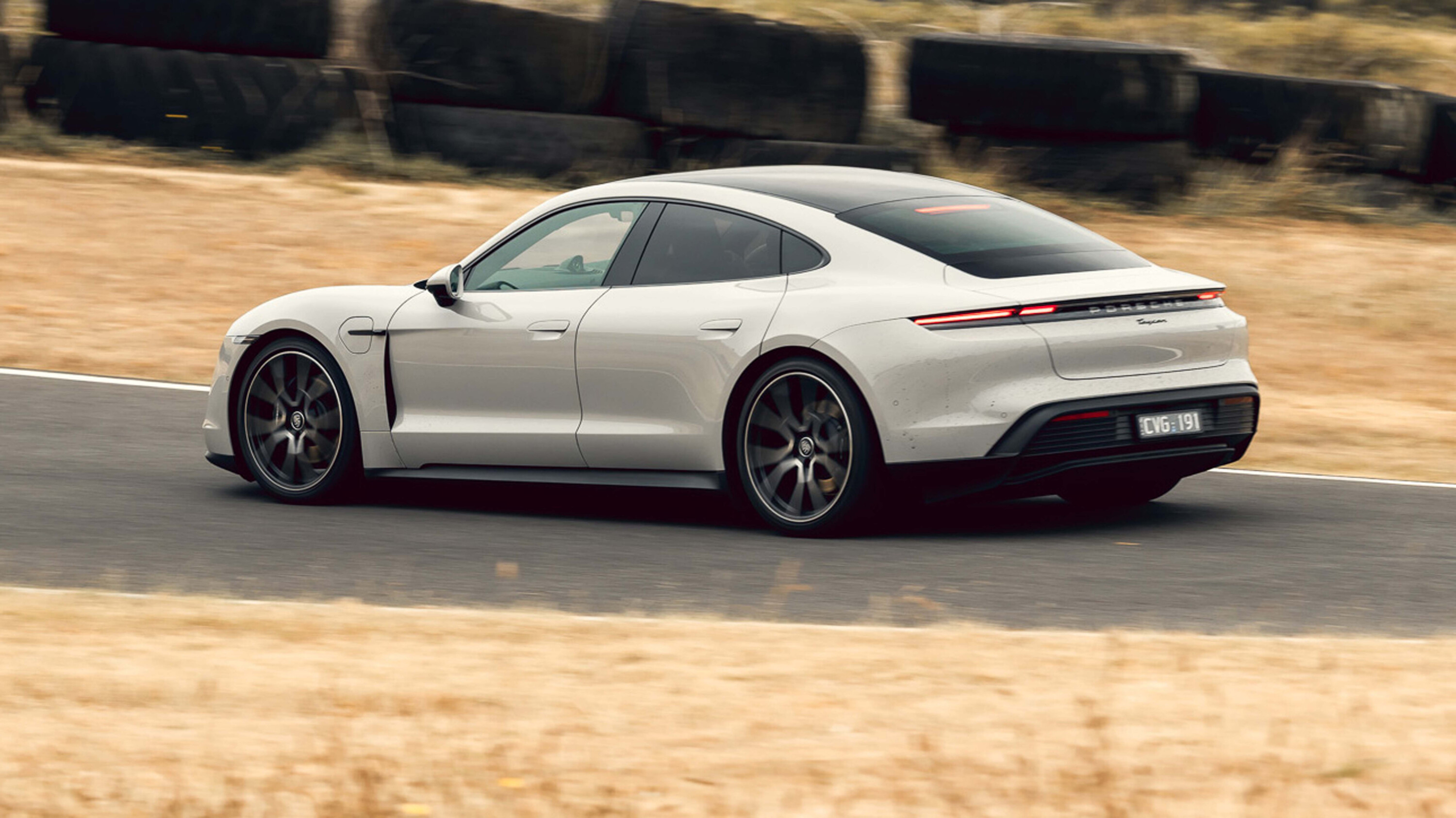
Having absorbed its futuristic, amphibian-esque exterior, the four-door liftback Taycan installs you low and ‘in’ the car, in classic sports car fashion.
Triple screens punctuate the leather-clad cabin and, when deactivated, hit home just how many core functions have been turned into code. Forget the volume, even the direction of the front air vents is controlled using the screens. With so few hard buttons and dials, you come to savour the feel of the stubby, 918 Spyder-style gear selector, the beautifully magnetic rotary drive mode selector on the steering wheel, even the indicator stalk.
At low speeds, fortunately there’s a bit more intrigue in how the Taycan drives. There are the usual EV traits – heaviness, quietness, instant torque under your right foot – but there’s also some polite mechanical whine from the drivetrain, while the two-speed rear gearbox can occasionally be felt changing gears.
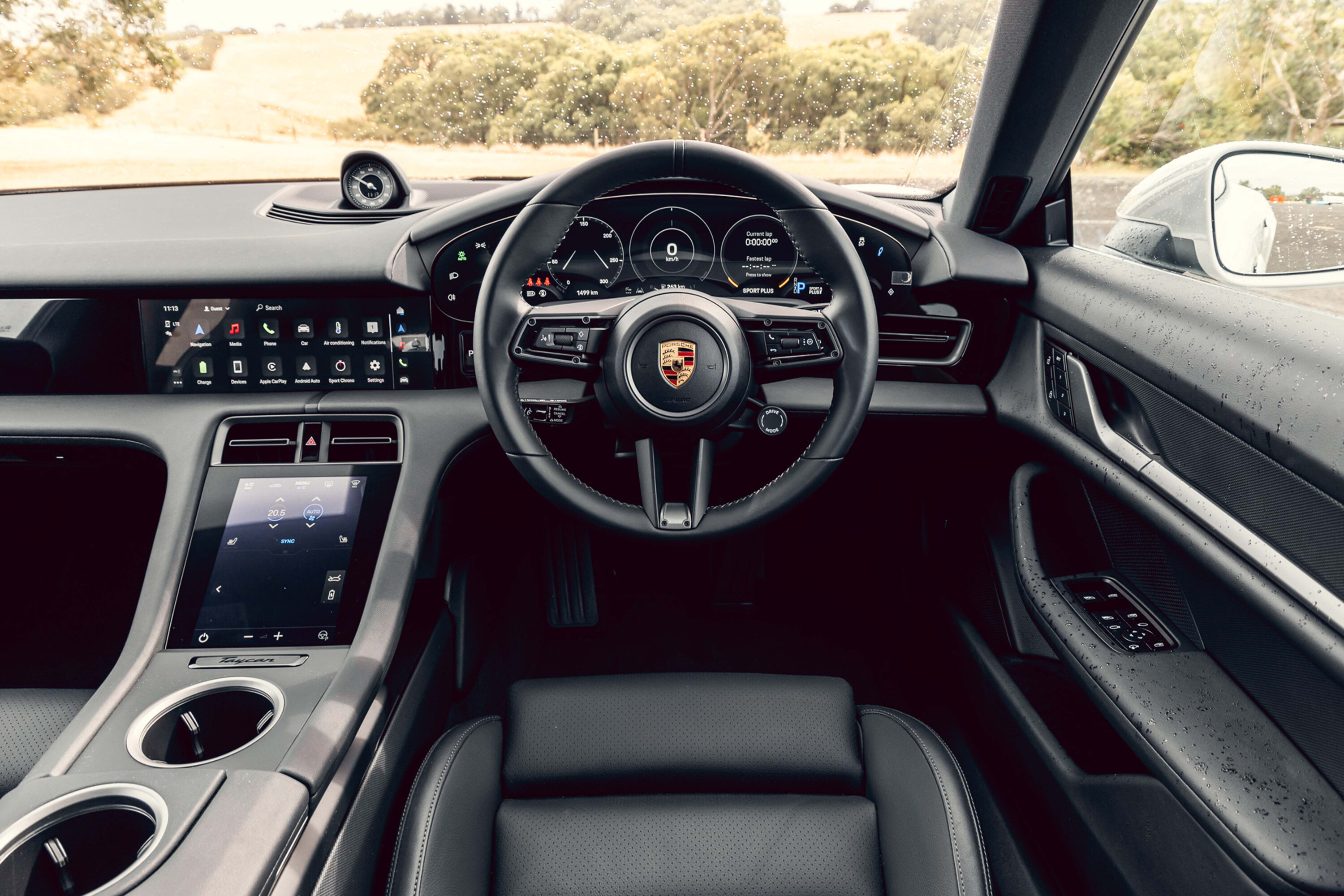
Minor things, but very welcome when most EVs are so perfectly quiet and smooth there’s nothing to be interested in.
Dynamically, there’s plenty to be interested in with the rear-drive Taycan. Compared to the upright Ioniq and the Mach-E, the flat, low and wide Taycan, with its double wishbone front-end and five-link rear, almost feels like an open-wheeler. Its 2130kg is situated very low, while fast and accurate steering gives it agility like a ballet-footed linebacker.
There’s plenty of mid-corner grip, while the default is understeer thanks in part to its aggressively staggered tyres (265 fronts, 305 rears) making it feel like a giant, heavy, long-wheelbase Cayman.
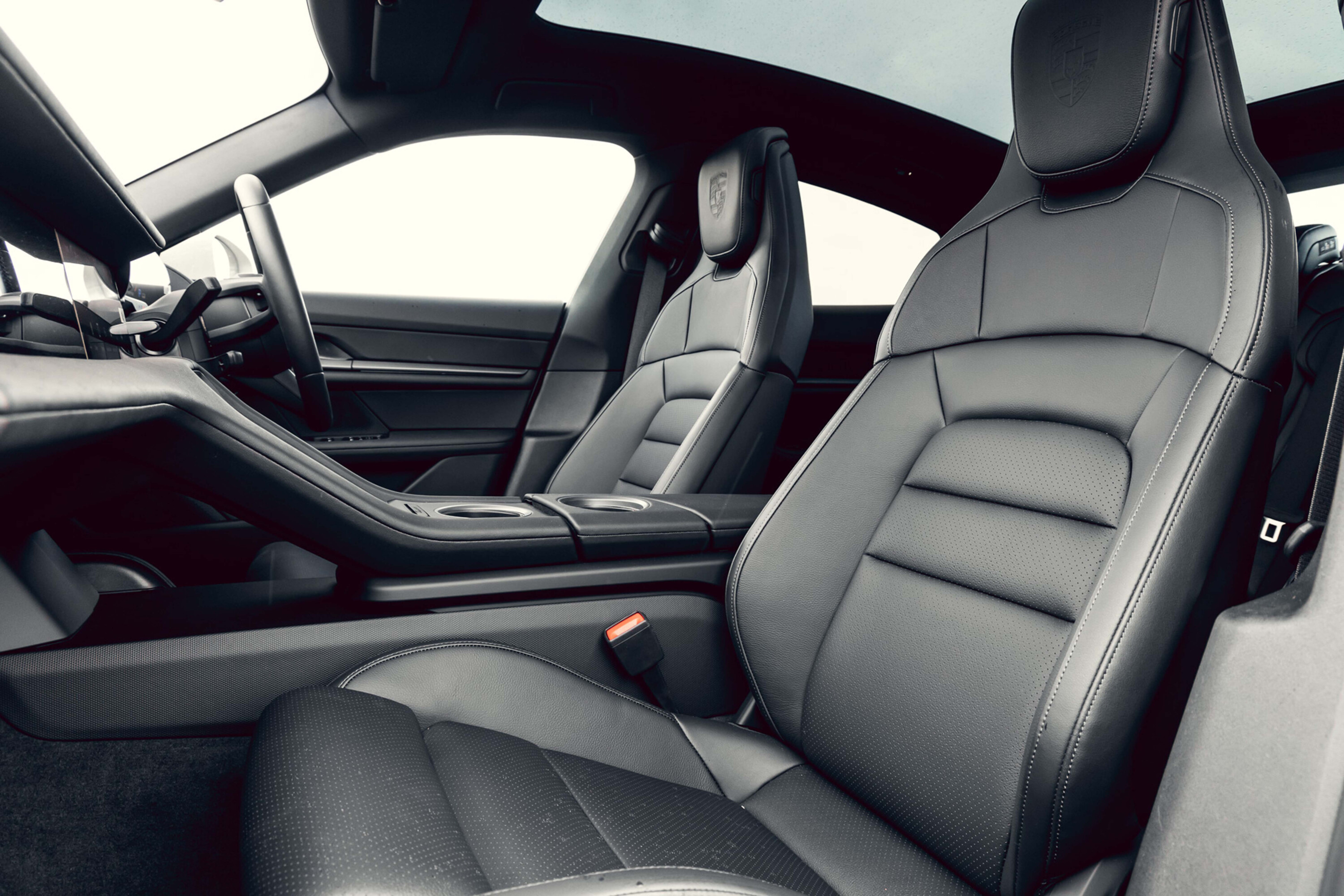
While with its single-motor, this Taycan lacks the visceral dual-motor punch of the Hyundai or Mustang (its claimed 5.4sec 0-100km/h time and 13.5sec 0-400m figures are almost limp mode for some electric models), turn the ESC off and power oversteer is there for the taking.
Where the Ioniq’s Drift Mode feels like you are interfacing with software, the more puristic Taycan offers a seemingly fixed relationship between throttle and motor, making it easier to know what it’s going to do next.
The fat rear tyres need every available electron to come unstuck, but once there it’s power oversteer for days – and it’s as much fun as it sounds.
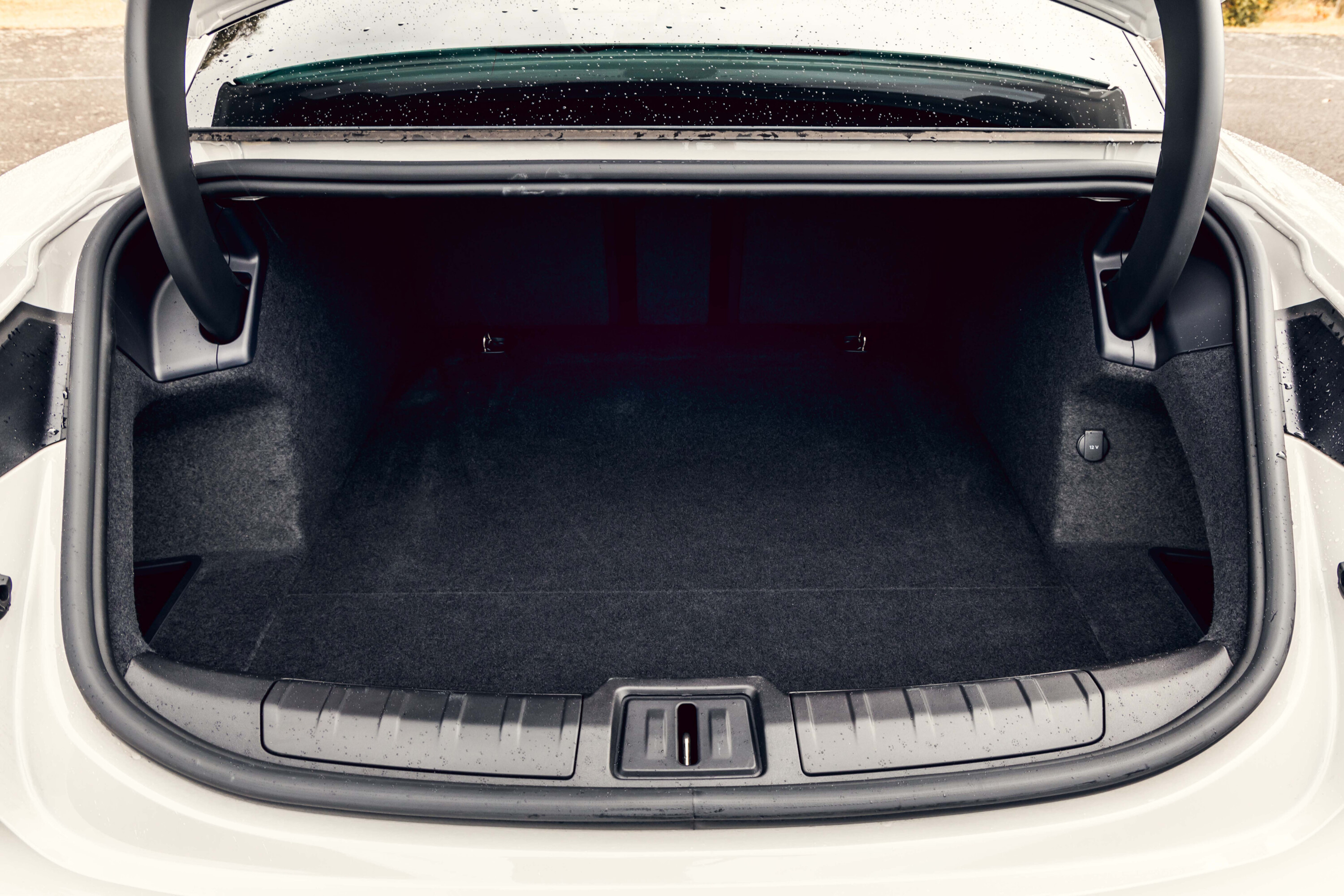
Back in the real world, perfection sadly evades the Taycan to an annoying degree.
The flush door handles make opening the doors fiddly, while on an incline the car can roll forward when selecting reverse. As minor as it sounds, the haptic control screen needs a forceful prod, but perhaps the strangest flaw is that the Taycan’s superstructure feels so stiff, the suspension is broadcast into the cabin in a booming, at-times unnerving way.
Sometimes at highway speeds there’s a muted buffeting like a rear window is open – but there isn’t.
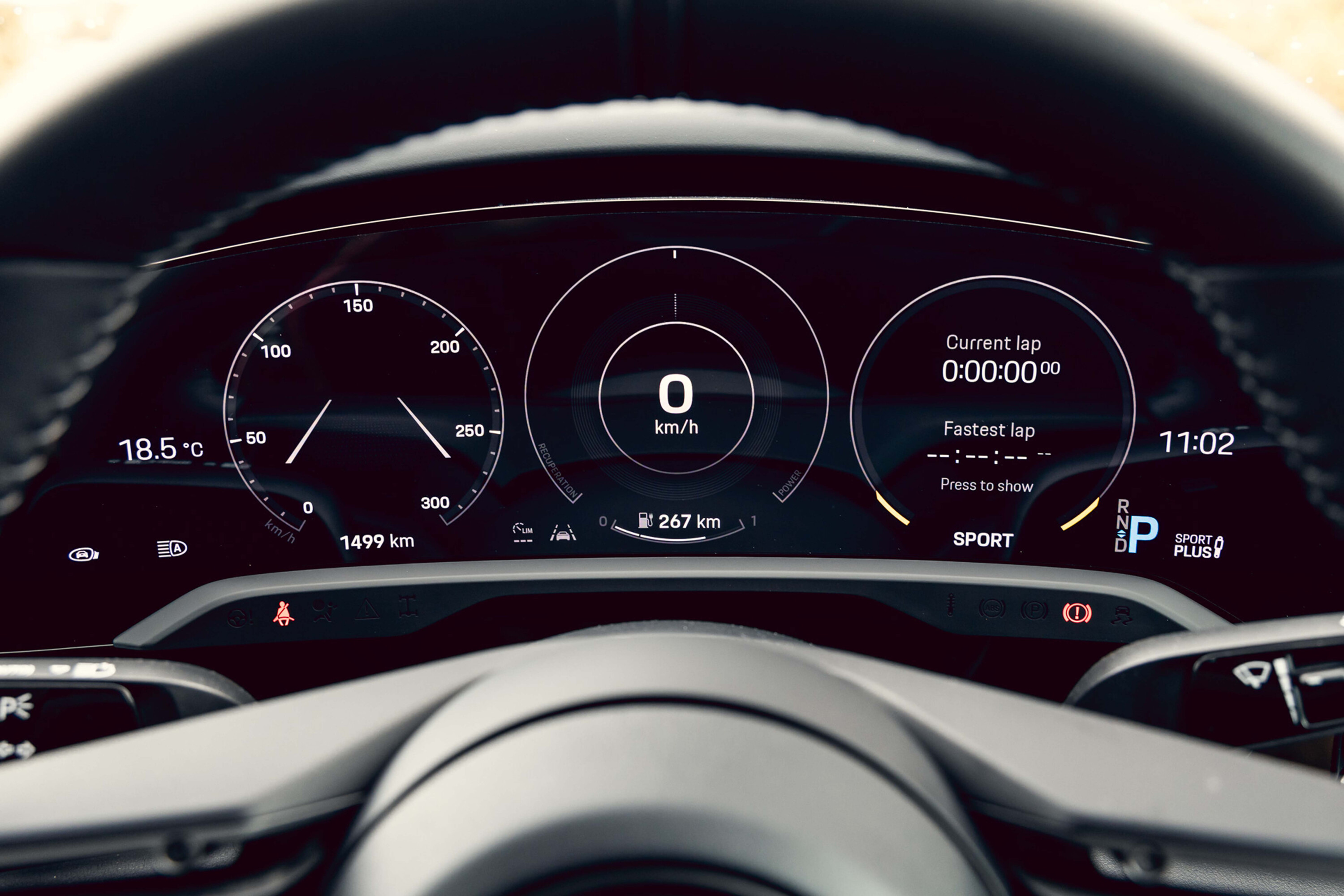
Then there’s the price – $164,400 before on-road costs, or $217,390 as-tested.
Range of 434km is also average, as is Porsche’s standard three-year, unlimited kilometre warranty.
But still, this is Best Performance EV, not Best Value EV With The Longest Warranty. On this basis there was a general consensus on our favourite vehicle – as you’ll soon read – but equally we would all be plenty happy with the Porsche which was a close second place.
The updated Taycan – with up to 320kW and 420Nm from its single rear-driven motor, and a bit more range – is due mid year. We’re sure the price will increase, but so will the appeal.

? Hyundai Ioniq 5 N
Don’t fear the EV future — Hyundai has built a game changer.
What we like
- Proof that EVs can be fast and hugely fun for keen driverst
- Gimmicks to make it feel like a petrol car actually work
- Big power and playful dynamics make it a bargain even at $111K
Not so much…
- Your tyre bill is going to be horrendous
- Can occasionally feel more computer game than proper driveru2019s car
- Steep learning curve to unlock the endless amount of drive modes and configurability
Game changer. Horribly overused, isn’t it? But as I tip the Hyundai Ioniq 5 N into another corner at Haunted Hills and once again feel it transition smoothly into an easily controlled drift, it’s hard to think of a better term for this overgrown Korean hatchback. An EV built for keen drivers that’s fast and genuinely fun? If this isn’t the performance-car world’s iPod moment, I’ll be shocked.
Let’s take stock: what we have here is an electric car that can seat five in comfort yet has more power than a McLaren F1.
It has also been deliberately engineered to feel, and sound, like a petrol car. It even has ‘gears’ and will happily smash into a fake rev limiter, arbitrarily chosen at 8000rpm, if you forget to pull the upshift paddle.
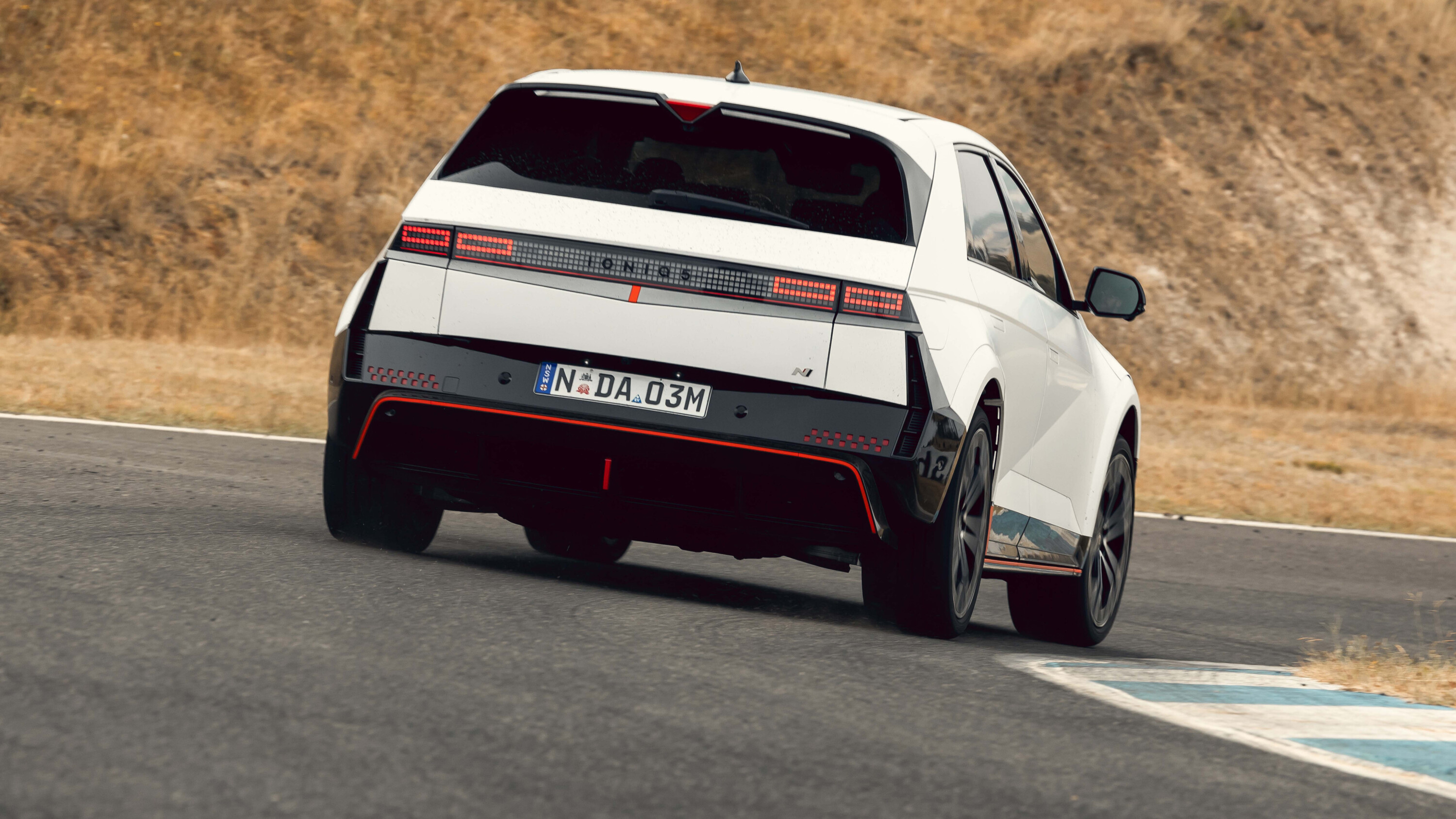
There are modes to help you hold enormous, tyre-shredding drifts, others to alter what kind of noise the car makes, and more still to vary the torque distribution and even how the brakes are used to help the car rotate in corners.
It’s incredibly gimmicky and configurable — the Playstation generation will love it — but consider the overriding goal. Until now, performance EVs have been fast but one dimensional. With the Ioniq 5 N, Hyundai’s focus is on injecting joy and boosting engagement.
Around Haunted Hills it’s a riot. With 478kW/770Nm available from twin electric motors, it’s noticeably more potent that the Porsche Taycan and about on par with the Audi RS e-tron GT for sheer urgency. But it’s how the Ioniq 5 N goes around corners that sets it apart.
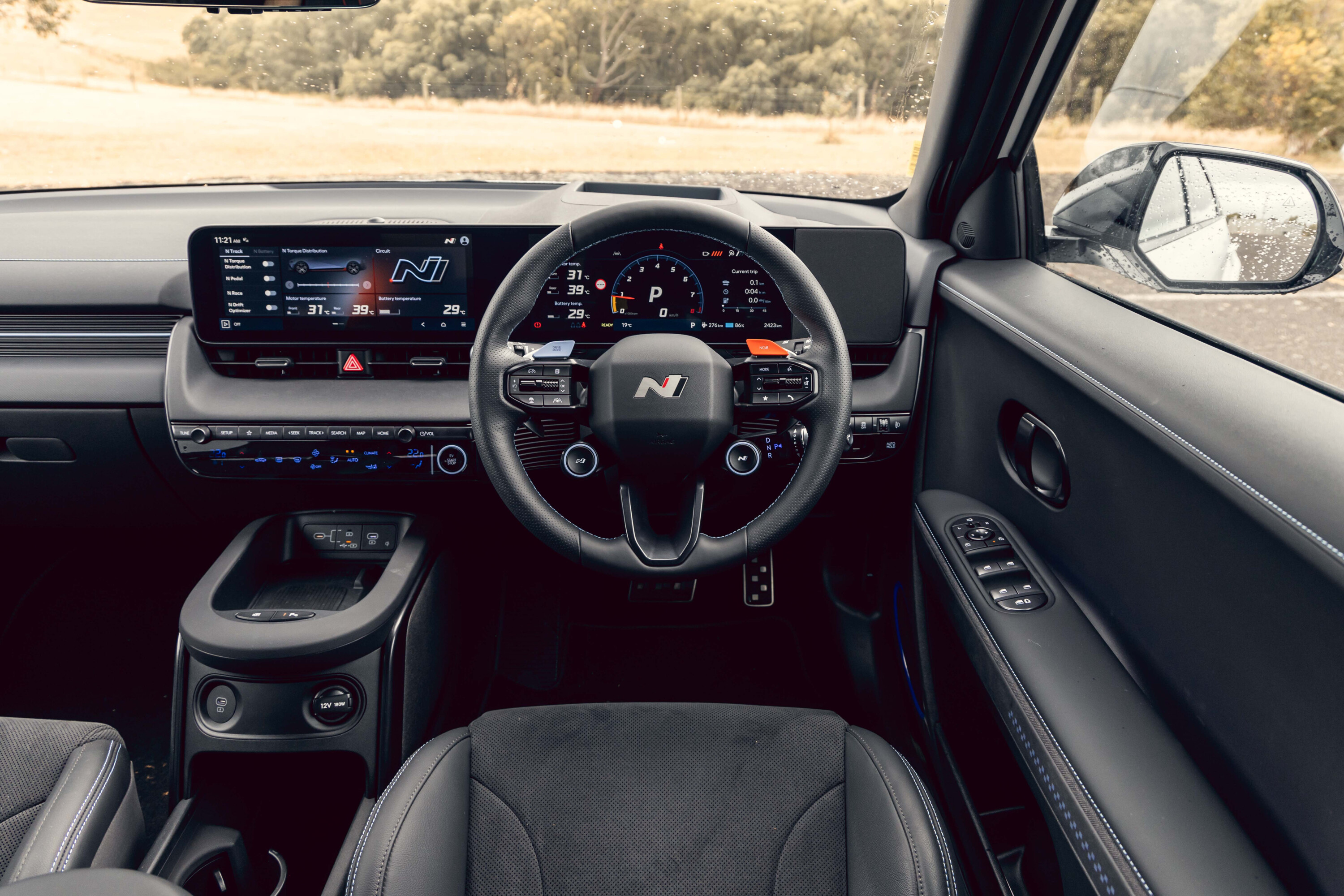
In its default setting it’s quick, accurate and grippy but start to play with the seemingly endless amount of drive mode adjustability and things get progressively more playful.
Nearly everything can be altered — the steering, suspension, e-diff, torque vectoring, ESC and throttle all have multiple modes — and with the traction control in its middle setting, the 5 N is a hoot around Haunted Hills.
The relatively quick steering is natural and accurate and the power delivery is so intuitive and immediate that you soon have the confidence to hustle the 5 N from apex to apex. Neat slides, both on the way into and out of corners, are at your beck and call.
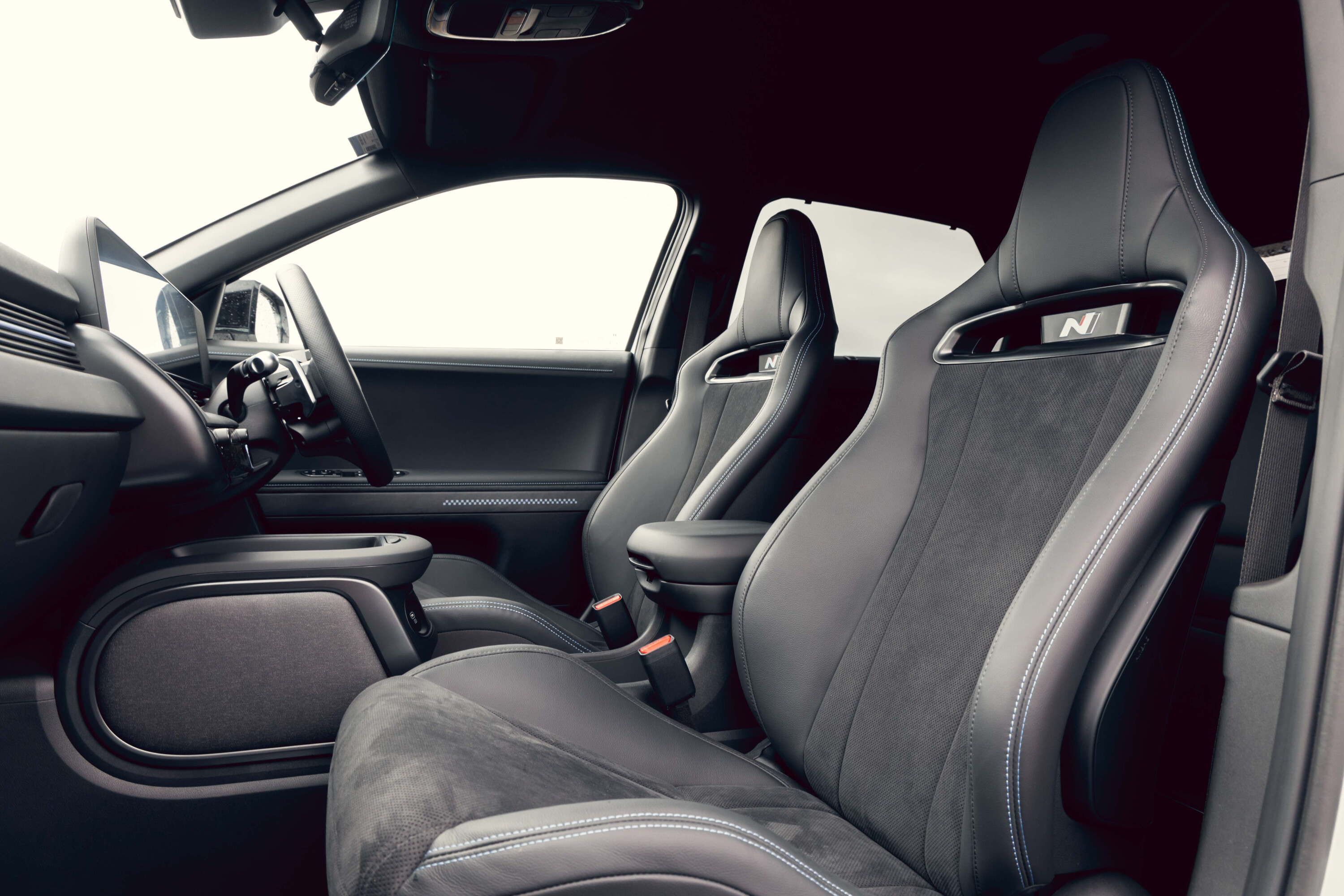
Then there’s the fake gearbox and simulated soundtrack, which add a welcome layer of engagement you simply don’t get in other fast EVs.
It’s laugh out loud enjoyable and crucially, also satisfyingly convincing. Downshifts give you a proper sense of ‘engine’ braking and unlike most sound generators, which are so crap you quickly turn them off, the 5 N’s is expertly matched to your speed and throttle position.
N Drift Control is a hoot, too, and allows you to execute big, smoky drifts on demand but it’s here you can notice the 5 N’s brain working hard in the background. “It feels like you’re interacting with software as much as you’re driving a car,” says Dylan.
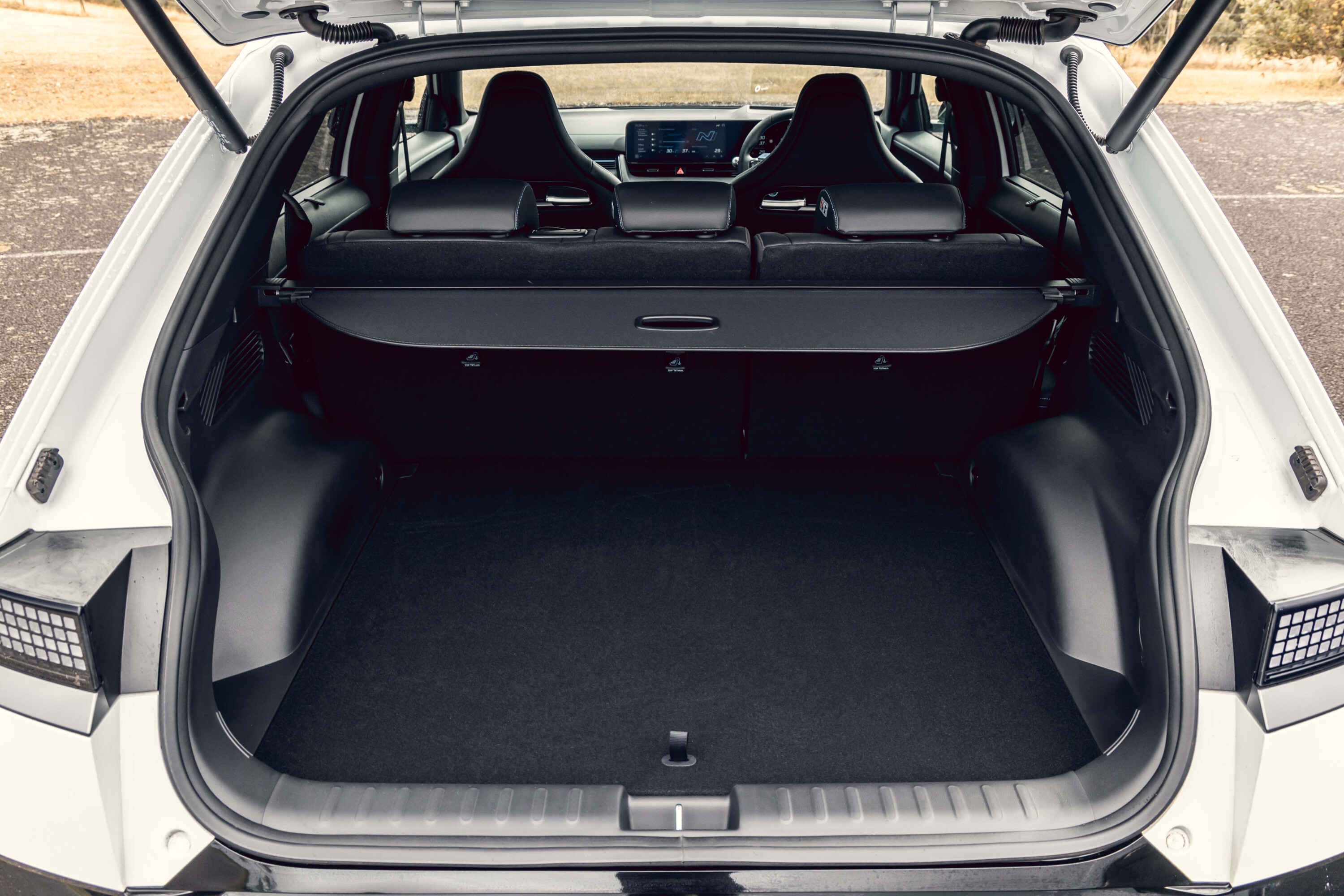
Crucially in such a heavy car the braking performance is impressive — colossal 400mm front rotors are clamped by four piston callipers — and N Pedal mode is yet another way to instigate a slide by using heavy regen to help rotate the car.
If it’s good on track, the 5 N is an even better road car. Aussie cars score a unique suspension tune and while body control is kept firmly in check, there’s enough wheel travel and suppleness to make this a convincing and comfortable cruiser.
Speaking of, the official WLTP range is 448km which is good but not great. Happily the 5N accepts up to 350kW DC charging and we got through an entire day of track driving, and a 300km round trip from Melbourne, with two 30 minute charges.

Okay, at $111,000 before on-roads, it’s expensive for a Hyundai.
But if that’s a sticking point consider how it stacks up for value against the Porsche Taycan and Audi e-tron RS GT also in this test, both of which it beat in the final reckoning. As Dylan said “As an EV that’s genuinely exciting and fun, the Hyundai nails it.”
A nagging question, however, is whether the novelty of the modes and gimmicks will wear off over time. They certainly won’t appeal to everyone but tellingly, when the moment came to complete some final laps at Haunted Hills, every member of the road-testing team made a beeline for the Hyundai.
It’s involving in ways other fast EVs simply aren’t. And proof that where engagement and fun cannot typically be found, they can be made. Hyundai hasn’t only moved the game on; it has changed it for the better.
⚡ 2024 Wheels Best EVs
Looking for an EV in a different size or price category? Visit our full Wheels Best EVs series at the links below.
? Wheels Best EVs
- Best Small Electric Car Under $40K
- Best Small Electric Car $40-50K
- Best Small Electric Car $50-60K
- Best Electric Small SUV
- Best Electric Midsize SUV
- Best Electric Midsize Sedan
? OVERALL WINNER: Best Electric Car Under $80K
PART 2
- Best Electric Large SUV
- Best Electric Small Luxury SUV
- Best Electric Midsize Luxury SUV
- Best Electric Luxury Sedan Under $100K
- Best Electric Luxury Sedan Over $100K
- Best Electric Performance Car
? OVERALL WINNER: Best Electric Car Over $80K
| Ford Mustang Mach-E | Abarth 500e | Audi RS e-tron GT | Porsche Taycan | Hyundai Ioniq 5 N | |
|---|---|---|---|---|---|
| Body | Five door, five-seat SUV | Three-door, four-seat hatch | Four-door sedan | Five-door, five-seat sedan | Five door, five-seat hatchback |
| Drive | Electric All-Wheel Drive | Front-wheel drive | All-wheel drive | Rear-wheel drive | All-wheel drive |
| Motor | Dual electric motors | 1 x front axle | Electric, permanently-excited synchronous motors | 1 x rear axle | 1 x each axle |
| Battery (gross/usable) | 91kWh | 42.2kWh/37.8kWh | 93.4kWh lithium-ion, 83.7kWh usable | 93.4kWh/83.7kWh | 84kWh |
| Power | 358kW | 114kW | 440kW (475kW with launch control) | 280kW | 448kW (478kW with boost mode) |
| Torque | 860Nm | 235Nm | 830Nm | 357Nm | 740Nm (770Nm with boost mode) |
| Claimed range | 490km | 253km (WLTP claimed) | 433km (WLTP) | 434km | 448km |
| Transmission | Single-speed automatic | Single-speed reduction gear | Single-speed on front motor, two-speed on rear motor | Two-speed | Single-speed reduction |
| 0-100km/h | 3.7 sec | 7.0sec (claimed) | 3.3 seconds | 5.4sec (claimed) | 3.4sec (with boost mode) |
| L/W/H | 4743/1881/1623 | 3673/1682/1518mm | 4989/2158/1401mm | 4963/1966/1394mm | 4715/1940/1585mm |
| Wheelbase | 2984 | 2322mm | 2900mm | 2900mm | 3000mm |
| Boot space | 519L | 185L | 350L | 84L (f), 407L (r) | 480L |
| Weight | 2717kg | 1410kg | 2422kg | 2130kg | 2230kg |
| Suspension | MagneRideu00ae Adaptive Suspension | Struts, coil springs, anti-roll bar (f) torsion beam, coil springs (r) | F: double wishbone, air springs, adaptive dampers, R: Multi-link, air springs, adaptive dampers | Double wishbone, adaptive dampers (f); multi-link, adaptive dampers (r) | MacPherson strut, coil springs, adaptive dampers, anti-roll bar (f) Multi-links, coil springs, adaptive dampers, anti-roll bar (r) |
| Brakes | Brembou00ae Performance Front Disc Brakes | 281mm discs with two-piston calipers (f) 278mm discs with single- piston caliper (r) | Steel, disc with fixed calipers | 360mm ventilated discs with 6-piston calipes (f), 358mm ventilated with 4-piston calipers (r) | 400mm discs with 4-piston callipers (f) 360mm discs with single-piston callipers (r) |
| Tyres | 245 / 45 R20 | 205/40 R18 | Goodyear Eagle F1, F : 265/35 R21, R: 305/30 R21 | 265/35ZR21 (f); 305/30ZR21 (r); Pirelli P Zero | Pirelli P Zero 275/35 R21 |
| Price | $104,990 | $58,900 | $246,875, $260,525 as-tested. | $111,000 before on-roads | |
| DC charging | 150kW | 85kW | 270kW maximum | 270kW | 350kW |
| AC charging | 10.5kW | 11kW | 11kW maximum | 11kW | 11kW |
We recommend
-
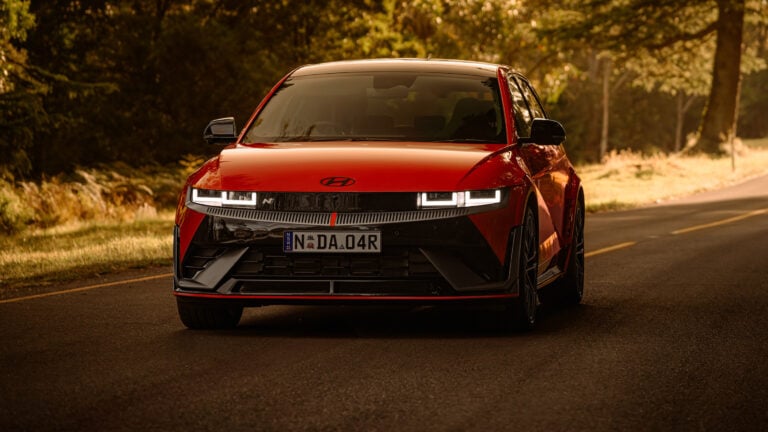 News
News2024 Hyundai Ioniq 5 N pricing: 478kW, $111k hero on sale now
Customers will have 12 hours to snaffle up the first batch of Hyundai’s high-performance EV, with orders opening on September 15
-
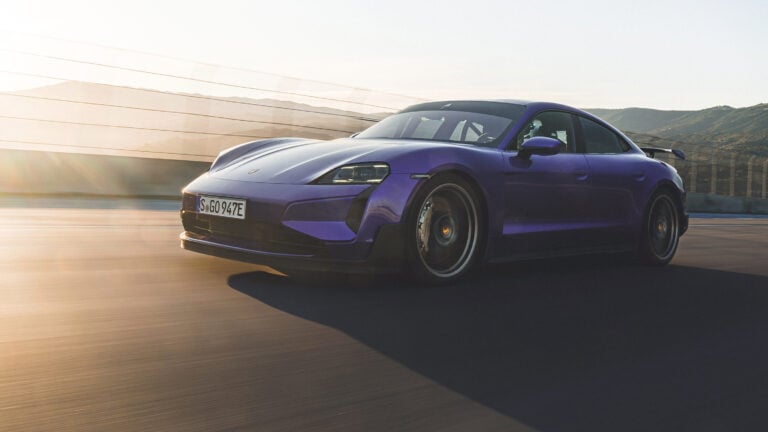 News
NewsPorsche Taycan Turbo GT pricing: $416k hero revealed
Porsche’s record setting and most powerful series-production model of all time will reach Australia in mid 2024 with a $416,600 starting price
-
 News
News2022 Audi E-Tron GT, RS E-Tron GT pricing and features
The E-Tron GT range is due to arrive on our shores later this year


